 In the days before remote controls you had to get out of your seat to make any adjustments to the television set such as adjusting the volume or changing the channel, etc., with the earliest televisions often only being capable of receiving one or two TV channels that were pre-defined for a particular transmitter by the supplying dealer if not done so at the factory.
In the days before remote controls you had to get out of your seat to make any adjustments to the television set such as adjusting the volume or changing the channel, etc., with the earliest televisions often only being capable of receiving one or two TV channels that were pre-defined for a particular transmitter by the supplying dealer if not done so at the factory.
 These manual controls often had a great tactile feel to them, especially the VHF channel selector which usually clicked when the knob was turned, and there were numerous other controls for picture adjustment (usually concealed at the sides or rear) which occasionally had to be adjusted due to valve-based circuitry drifting out of alignment, hence the importance of the test card and tuning signal broadcasts prior to the 1980s because they were used to correctly set up a television receiver.
These manual controls often had a great tactile feel to them, especially the VHF channel selector which usually clicked when the knob was turned, and there were numerous other controls for picture adjustment (usually concealed at the sides or rear) which occasionally had to be adjusted due to valve-based circuitry drifting out of alignment, hence the importance of the test card and tuning signal broadcasts prior to the 1980s because they were used to correctly set up a television receiver.
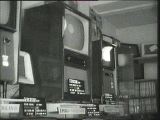
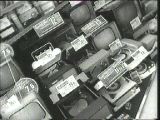
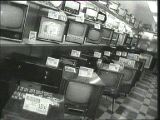
 So what were the shops that sold televisions like in the 1950s? The pictures above show a typical example – this was the era before the advent of the big superstore, so lots of receivers were packed into a relatively small shop space (though some department stores also sold televisions, of course). The brand names are mainly unfamiliar, and there’s a complete absence of anything resembling a video recorder. Only one set is showing a picture, and it is Test Card C which was a very common daytime sight in this period.
So what were the shops that sold televisions like in the 1950s? The pictures above show a typical example – this was the era before the advent of the big superstore, so lots of receivers were packed into a relatively small shop space (though some department stores also sold televisions, of course). The brand names are mainly unfamiliar, and there’s a complete absence of anything resembling a video recorder. Only one set is showing a picture, and it is Test Card C which was a very common daytime sight in this period.
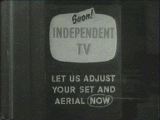 The dawn of commercial television (ITV) in 1955 – TV shops in the London and Midlands had signs like this one in the window as retailers promoted the forthcoming ITV service.
The dawn of commercial television (ITV) in 1955 – TV shops in the London and Midlands had signs like this one in the window as retailers promoted the forthcoming ITV service.
 If you already had a TV set and wanted ITV as well…prepare to be converted – at a price, of course. In front is a card promoting Ferguson TV’s. “Fine sets those Ferguson’s” was the slogan used at the time.
If you already had a TV set and wanted ITV as well…prepare to be converted – at a price, of course. In front is a card promoting Ferguson TV’s. “Fine sets those Ferguson’s” was the slogan used at the time.
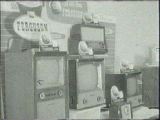 And talking of Ferguson, here’s a selection of Ferguson TV’s and radio’s from the mid 1950s. Ferguson were taken over by the Thorn-EMI empire, which then sold the brand to Thomson (100% owned by the French government), though Thomson has now ceased to exist in the UK. Brands like Alba, Bush and Murphy are now the preserve of retailers and mail order catalogues who basically just use the name for their own-branded products.
And talking of Ferguson, here’s a selection of Ferguson TV’s and radio’s from the mid 1950s. Ferguson were taken over by the Thorn-EMI empire, which then sold the brand to Thomson (100% owned by the French government), though Thomson has now ceased to exist in the UK. Brands like Alba, Bush and Murphy are now the preserve of retailers and mail order catalogues who basically just use the name for their own-branded products.
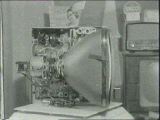 There were many more brands of television prior to the 1980s, most of which have long since disappeared altogether or absorbed into multinational companies. Here is a picture of the innards of an Ekco television of the mid 1950s.
There were many more brands of television prior to the 1980s, most of which have long since disappeared altogether or absorbed into multinational companies. Here is a picture of the innards of an Ekco television of the mid 1950s.
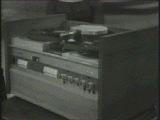 Moving forward ten years to 1965, and the introduction of one of the first ‘affordable’ video tape recording machines – the Philips EL3400. It was bulky and used an exposed reel of tape, plus it only recorded in black and white despite colour transmissions being available not long afterwards. It also had no tuner or timer facility, so it was only useful with (sometimes) expensive external ancillary equipment such as a separate television tuner or video camera. However, two years before the EL3400 there was a British recorder advertised for sale called the Telcan that was possibly the world’s first domestic video recorder. It could record approximately 20 minutes of 405 line video and audio onto audio tape; a remarkable feat for relatively primitive technology but was a commercial failure presumably due to the short length of its recordings. Only two examples of the Telcan are known to exist nowadays.
Moving forward ten years to 1965, and the introduction of one of the first ‘affordable’ video tape recording machines – the Philips EL3400. It was bulky and used an exposed reel of tape, plus it only recorded in black and white despite colour transmissions being available not long afterwards. It also had no tuner or timer facility, so it was only useful with (sometimes) expensive external ancillary equipment such as a separate television tuner or video camera. However, two years before the EL3400 there was a British recorder advertised for sale called the Telcan that was possibly the world’s first domestic video recorder. It could record approximately 20 minutes of 405 line video and audio onto audio tape; a remarkable feat for relatively primitive technology but was a commercial failure presumably due to the short length of its recordings. Only two examples of the Telcan are known to exist nowadays.
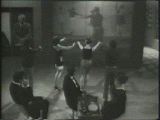 Compared to the Telcan, the EL3400 was a greater success and certainly had its uses, as a group of dancers watch themselves perform on a large video projection screen. The EL3400 did not come cheap because it used a helical scan recording technique also used by professional recorders like the Ampex Quadraplex (the world’s first broadcast quality video recorder), so it was typically found only in large education establishments or used for industrial applications. Also Japanese companies such as Shibaden and Sony were starting to make their presence felt at this time with recorders like the CV-2000 format reel to reel machines which were soon followed by the U-Matic video cassette that proved popular in the industrial and commercial markets.
Compared to the Telcan, the EL3400 was a greater success and certainly had its uses, as a group of dancers watch themselves perform on a large video projection screen. The EL3400 did not come cheap because it used a helical scan recording technique also used by professional recorders like the Ampex Quadraplex (the world’s first broadcast quality video recorder), so it was typically found only in large education establishments or used for industrial applications. Also Japanese companies such as Shibaden and Sony were starting to make their presence felt at this time with recorders like the CV-2000 format reel to reel machines which were soon followed by the U-Matic video cassette that proved popular in the industrial and commercial markets.
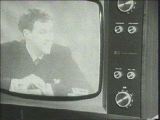 The common face of television in the mid to late 1960s – black and white, dual standard (though lots of single-standard 405 line VHF-only televisions remained in use for many years) with separate controls for 405-line VHF and 625-line UHF transmissions. This was required since from 1964 the new BBC2 service was only available on UHF.
The common face of television in the mid to late 1960s – black and white, dual standard (though lots of single-standard 405 line VHF-only televisions remained in use for many years) with separate controls for 405-line VHF and 625-line UHF transmissions. This was required since from 1964 the new BBC2 service was only available on UHF.
 1967 saw the arrival of the first mass produced colour TV’s for the UK market, though their high price and initial lack of colour programming (BBC2 only until 1969, few transmitters provided a colour signal and not all programmes were in colour) ensured slow sales to begin with. The picture shows an HMV Colourmaster which was typical of the sets produced in the late 1960s. Find out more about early colour television on the Colour Television page.
1967 saw the arrival of the first mass produced colour TV’s for the UK market, though their high price and initial lack of colour programming (BBC2 only until 1969, few transmitters provided a colour signal and not all programmes were in colour) ensured slow sales to begin with. The picture shows an HMV Colourmaster which was typical of the sets produced in the late 1960s. Find out more about early colour television on the Colour Television page.
 Fast forward to 1972 – though a few lucky buyers may have had access to one in 1971 – and the launch of the first ‘proper’ ‘home’ video recorder with an integrated tuner and timer, the Philips N1500. This close-up view (disregard the Sony machine just visible) shows the sloping front panel with (from left to right) a recording level meter, tape transport controls, and the 1 day, 1 event ‘egg timer’ clock. Each large Philips VCR cassette could record up to 30 or 60 (later 80) minutes; the six channel selector buttons are visible above the transport controls. The only thing to put off a potential purchaser – apart from the relatively short running time – was the steep price tag. However the N1500 was not generally available until the end of 1973; earlier it was only sold to schools and corporate customers, and these customers remained the main purchasers of such an expensive device. The less than 90 minutes maximum recording time would have limited its appeal to wealthy people who weren’t interested in recording long movies, therefore it tended to be only specialist shops and upmarket department stores that stocked the recorder.
Fast forward to 1972 – though a few lucky buyers may have had access to one in 1971 – and the launch of the first ‘proper’ ‘home’ video recorder with an integrated tuner and timer, the Philips N1500. This close-up view (disregard the Sony machine just visible) shows the sloping front panel with (from left to right) a recording level meter, tape transport controls, and the 1 day, 1 event ‘egg timer’ clock. Each large Philips VCR cassette could record up to 30 or 60 (later 80) minutes; the six channel selector buttons are visible above the transport controls. The only thing to put off a potential purchaser – apart from the relatively short running time – was the steep price tag. However the N1500 was not generally available until the end of 1973; earlier it was only sold to schools and corporate customers, and these customers remained the main purchasers of such an expensive device. The less than 90 minutes maximum recording time would have limited its appeal to wealthy people who weren’t interested in recording long movies, therefore it tended to be only specialist shops and upmarket department stores that stocked the recorder.
The N1500 was replaced by the N1502 in 1976, which was basically an updated N1500 with a more modern case, a digital timer and a few extra features like a ‘Stop motion’ button which froze the picture on-screen. Indeed the N1502 looked almost identical to the forthcoming N1700 which was known to be in development at the time, so the N1502 was probably produced as a stop-gap.
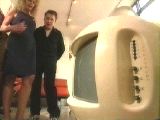
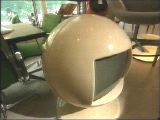
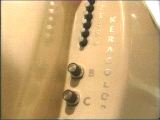
Space oddity…Anyone who walked into the television department of a large upmarket department store (such as Harrods in London) in the 1970s may have been confronted with this space helmet-shaped television known as the Keracolor. This rare model is a design classic, and with 1970s style back in fashion a reconditioned Keracolor retailed in 1998 for as much as £800. Produced in Northwich, Cheshire, there were colour and monochrome versions as well as a smaller portable version, and at least the colour sets used a Decca chassis supported by stickle bricks. (Yes, stickle bricks!) The Keracolor brand was revived much more recently but sadly failed to make a discernible impact on the television world, even minus the stickle bricks.
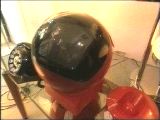

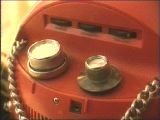
Send in the clones…the 1970s saw the rise of Japanese manufacturers in Europe and elsewhere, displacing many established companies both in the UK and abroad. Many of the Japanese products from this period were heavily influenced by European models; the JVC Videosphere pictured here being another helmet-based design. The right-hand picture shows the set’s controls – the thumbwheel controls (from left to right) are for brightness, contrast, and off-on/volume, plus rotary VHF and UHF tuning controls. The example shown here is rare since this monochrome TV usually had an orange casing; even so, compared to the Keracolor it is relatively affordable with a 1998 price of £330. Incidentally, the pictures of both this and the Keracolor were taken from BBC Two’s The Antiques Show.
1976 was the year that teletext receivers were sold in UK shops for the very first time, enabling news and information to be displayed on a television screen at a push of a button, but they still weren’t widely available for at least another year. There had been a public teletext service operational since September 1974, but at the start there were only three teletext receivers in existence and they couldn’t be bought in shops, though an electronics magazine published a guide to building your own teletext decoder in 1975 for those who were technically proficient enough to build one from scratch. The Labgear external decoder was the first to be manufactured and sold to the public, with four channels selectable using push buttons on the front panel and a wired remote control used to select pages and other teletext features such as hold and reveal.
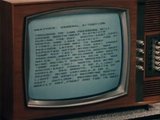 CEEFAX had been demonstrated by the BBC to the public as early as a news report on 23 October 1972, but IBA engineers had been independently working on their own ORACLE system therefore it took two years for the two incompatible systems to be reworked into a single standard known as teletext and for broadcasts to commence, with the acronyms CEEFAX and ORACLE being used as the two brand names for the BBC and IBA (ITV) services using the same teletext standard. The falling price of digital electronics made teletext much more affordable during the 1980s and proved to be popular in the UK, remaining in use until it was made obsolete by the analogue TV transmission switch off.
CEEFAX had been demonstrated by the BBC to the public as early as a news report on 23 October 1972, but IBA engineers had been independently working on their own ORACLE system therefore it took two years for the two incompatible systems to be reworked into a single standard known as teletext and for broadcasts to commence, with the acronyms CEEFAX and ORACLE being used as the two brand names for the BBC and IBA (ITV) services using the same teletext standard. The falling price of digital electronics made teletext much more affordable during the 1980s and proved to be popular in the UK, remaining in use until it was made obsolete by the analogue TV transmission switch off.
1977 saw the mass market arrival of a piece of technology that would prove to be very popular for more than 20 years and is still used by many people today, the VCR… (Pictures copyright: Philips Electronics.)
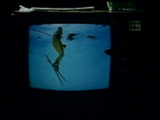

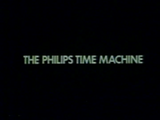

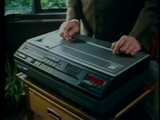 Before the video cassette recorder (VCR) became popular during the 1980s, it was necessary to explain to potential customers exactly what a VCR was and what it could actually do, and those potential customers may not be mechanically-minded either, so the best person to explain what a VCR did in layman’s terms is someone who is recognisably an expert in television but who isn’t necessarily an expert in things mechanical, namely someone like the writer and presenter Denis Norden, therefore Philips were extremely lucky to be able to have Norden present their promotional video demonstrating the benefits of their brand new N1700 VCR. It’s interesting that Philips chose to describe their VCR as simply a “Time Machine” as opposed to a “Television Time Machine” which would have been a much more precise description of what it could do if perhaps a less eye-catching expression.
Before the video cassette recorder (VCR) became popular during the 1980s, it was necessary to explain to potential customers exactly what a VCR was and what it could actually do, and those potential customers may not be mechanically-minded either, so the best person to explain what a VCR did in layman’s terms is someone who is recognisably an expert in television but who isn’t necessarily an expert in things mechanical, namely someone like the writer and presenter Denis Norden, therefore Philips were extremely lucky to be able to have Norden present their promotional video demonstrating the benefits of their brand new N1700 VCR. It’s interesting that Philips chose to describe their VCR as simply a “Time Machine” as opposed to a “Television Time Machine” which would have been a much more precise description of what it could do if perhaps a less eye-catching expression.
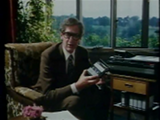 The N1700 recorded television broadcasts onto the same size cassette tapes as the N1500, with up to 2 hours of record and play time initially available (Long Play = LP) compared to the 1 hour duration offered by the earlier N1500 series machines (including the N1502 which looked very similar to the N1700); this was achieved by slowing the tape speed down and using improved electronics, therefore recordings were incompatible between VCR-LP and the earlier VCR machines. Even longer tapes were later introduced, enabling 3 hours of recording time on VCR-LP recorders in order to compete with the new VHS and Betamax recorders offered by Japanese manufacturers that were launched in the UK during 1978. (Betamax and VHS had already launched in Japanese/US NTSC markets; 1975 for Betamax and 1976 for VHS respectively, so Philips knew that competition for their product was soon to appear in Europe.)
The N1700 recorded television broadcasts onto the same size cassette tapes as the N1500, with up to 2 hours of record and play time initially available (Long Play = LP) compared to the 1 hour duration offered by the earlier N1500 series machines (including the N1502 which looked very similar to the N1700); this was achieved by slowing the tape speed down and using improved electronics, therefore recordings were incompatible between VCR-LP and the earlier VCR machines. Even longer tapes were later introduced, enabling 3 hours of recording time on VCR-LP recorders in order to compete with the new VHS and Betamax recorders offered by Japanese manufacturers that were launched in the UK during 1978. (Betamax and VHS had already launched in Japanese/US NTSC markets; 1975 for Betamax and 1976 for VHS respectively, so Philips knew that competition for their product was soon to appear in Europe.)

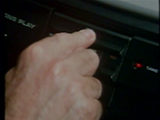
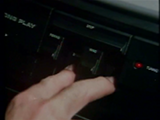

So using the N1700 is as straightforward as: (a) Switching it on; (b) Selecting a TV channel to record from, using the buttons marked 1 to 8; (c) Press the Record and Play buttons down together to start the recording; (d) Press the Stop button to stop the recording. Simple! (The N1500 was nearly as easy to use with perhaps the added complication of setting an audio record level control.)
 Just like the earlier N1500/N1502 models, the N1700 VCR recorded television broadcasts onto removable cassette tapes, therefore you had to have inserted a tape into the machine in the first place and ensured that there was enough free space on the tape for a new recording, if necessary rewinding the tape to a suitable point (or the beginning) as shown here, but anyone already familiar with audio cassette recording as most people were at that point during the 1970s would instinctively understand such concepts even if people under the age of 25 nowadays would be even more clueless about VCR’s as the average person would have been in the 1970s. The N1700 did the job it was designed to do on a basic level, but it had no remote control and no picture search facility so you had to make use of a mechanical tape counter and/or the tape compartment window to work out exactly how much tape was left for recording/playback.
Just like the earlier N1500/N1502 models, the N1700 VCR recorded television broadcasts onto removable cassette tapes, therefore you had to have inserted a tape into the machine in the first place and ensured that there was enough free space on the tape for a new recording, if necessary rewinding the tape to a suitable point (or the beginning) as shown here, but anyone already familiar with audio cassette recording as most people were at that point during the 1970s would instinctively understand such concepts even if people under the age of 25 nowadays would be even more clueless about VCR’s as the average person would have been in the 1970s. The N1700 did the job it was designed to do on a basic level, but it had no remote control and no picture search facility so you had to make use of a mechanical tape counter and/or the tape compartment window to work out exactly how much tape was left for recording/playback.
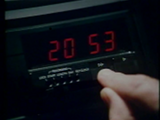 The N1700 did have a basic digital timer capable of recording one programme that had a start time at some point during the next three days, which at least was an improvement over the first Philips VCR N1500 that could only manage a recording start time during the next 24 hours (and was a mechanical timer similar to that used on an old cooker); the N1700 timer was set using a sliding control which was moved one step at a time from left to right, setting the day, start time, and programme duration in that order. Simple and relatively foolproof if not the last word in sophistication, but anything more complex would have made the N1700 too expensive when Philips was trying to keep the overall product cost down.
The N1700 did have a basic digital timer capable of recording one programme that had a start time at some point during the next three days, which at least was an improvement over the first Philips VCR N1500 that could only manage a recording start time during the next 24 hours (and was a mechanical timer similar to that used on an old cooker); the N1700 timer was set using a sliding control which was moved one step at a time from left to right, setting the day, start time, and programme duration in that order. Simple and relatively foolproof if not the last word in sophistication, but anything more complex would have made the N1700 too expensive when Philips was trying to keep the overall product cost down.
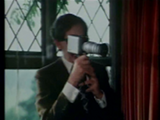 If you were really wealthy in the 1970s, you could not only afford a VCR but also have the disposable income to buy an optional camera to plug in the back of it, meaning that you could record home movies on your VCR as long as the lead between camera and VCR was long enough to reach where you wanted to record; fine for recording children playing in the living room or perhaps in the garden from the patio but useless for many other parts of the house or outside. Also the cheap cameras only recorded in black and white, therefore colour recording required additional expense as well as good lighting because the camera tubes weren’t very sensitive to light, so that candlelit dinner party recording may turn out to be a complete washout unless very bright lights were used.
If you were really wealthy in the 1970s, you could not only afford a VCR but also have the disposable income to buy an optional camera to plug in the back of it, meaning that you could record home movies on your VCR as long as the lead between camera and VCR was long enough to reach where you wanted to record; fine for recording children playing in the living room or perhaps in the garden from the patio but useless for many other parts of the house or outside. Also the cheap cameras only recorded in black and white, therefore colour recording required additional expense as well as good lighting because the camera tubes weren’t very sensitive to light, so that candlelit dinner party recording may turn out to be a complete washout unless very bright lights were used.
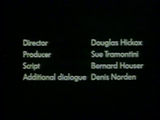
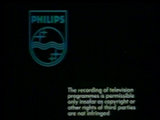
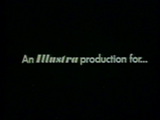
Denis Norden not only presented the promotion but contributed to its script, being a famous scriptwriter himself having worked alongside Frank Muir amongst others in the past, and this showed in the humourous touches employed including various interactions with his wife (whom you don’t actually see), such as getting ready to go out therefore being able to set the VCR to record something whilst away, etc.; this promotion wasn’t just a factual explanation of how to use a video cassette recorder.
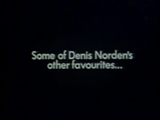


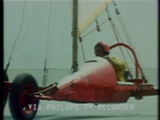
After the practical lesson there were three films intended to be shown in shops for demonstration purposes; skiing, canoeing and land yachting. The skiing film had an accompanying musical soundtrack (Psyche Rock by Pierre Henry) whilst the others featured a natural soundtrack, though there’s another version of the canoeing film with Psyche Rock music also used as a shop demonstration for the N1700.
Grundig produced its own SVR format based on Philips VCR-LP tapes but offering even longer recording times, though it wasn’t popular due to poor availability combined with a near absence of pre-recorded tapes. By 1978 the Japanese-developed Betamax (Sony) and VHS (JVC) videotape formats reached the UK, both offering longer recording times and a wider choice of recorders from different manufacturers compared to Philips’s VCR-LP format. Philips countered by offering a 3 hour tape for the N1700 and the Philips recorder was still the best-selling VCR in 1979 despite the new competition. Philips was also developing a new Video 2000 tape format which unfortunately didn’t reach the market until 1980 when VHS in particular was rapidly becoming established due to greater support from dealers and popularity with schools.

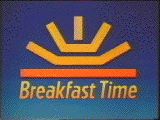 There had been occasional attempts at breakfast television in the UK previously (Yorkshire Television’s Good Morning Calendar for ITV (Yorkshire region only) in 1977 and later on BBC1’s Swap Shop tried an earlier start with AM-UK), but the market for breakfast television was still considered to be limited in the UK because it was thought that most people might be too busy to watch television at that time of the day. Once a commercial breakfast television franchise had been created and awarded to TV-am in 1980 alongside other ITV franchise changes, TV-am’s launch was scheduled for 1 February 1983 in order to avoid the other ITV franchise changes at the start of 1982 as well as the launch of Channel 4 the following November. However the BBC decided to get in first with a ‘spoiler’ programme, namely Breakfast Time on BBC1 which launched a month earlier, and much to TV-am’s dismay (they were due on air shortly) it was not the serious news programme some thought it might have been, but was a direct competitor which helped to hit TV-am’s initial viewing figures badly. Later on, Breakfast Time was scrapped and replaced with a more serious BBC Breakfast News format.
There had been occasional attempts at breakfast television in the UK previously (Yorkshire Television’s Good Morning Calendar for ITV (Yorkshire region only) in 1977 and later on BBC1’s Swap Shop tried an earlier start with AM-UK), but the market for breakfast television was still considered to be limited in the UK because it was thought that most people might be too busy to watch television at that time of the day. Once a commercial breakfast television franchise had been created and awarded to TV-am in 1980 alongside other ITV franchise changes, TV-am’s launch was scheduled for 1 February 1983 in order to avoid the other ITV franchise changes at the start of 1982 as well as the launch of Channel 4 the following November. However the BBC decided to get in first with a ‘spoiler’ programme, namely Breakfast Time on BBC1 which launched a month earlier, and much to TV-am’s dismay (they were due on air shortly) it was not the serious news programme some thought it might have been, but was a direct competitor which helped to hit TV-am’s initial viewing figures badly. Later on, Breakfast Time was scrapped and replaced with a more serious BBC Breakfast News format. TV-am followed swiftly afterwards, launched with a barrage of publicity on 1st February 1983. It featured a mixture of familiar and unfamiliar presenters (David Frost being the key figure) and had a ‘bright and breezy’ approach to waking the nation up in the morning. Expectations were set high for the new service, but in reality there were several unanswered questions; most notably just how many people in the UK were prepared to watch television instead of listening to the radio at that time of day especially given the BBC1 competition.
TV-am followed swiftly afterwards, launched with a barrage of publicity on 1st February 1983. It featured a mixture of familiar and unfamiliar presenters (David Frost being the key figure) and had a ‘bright and breezy’ approach to waking the nation up in the morning. Expectations were set high for the new service, but in reality there were several unanswered questions; most notably just how many people in the UK were prepared to watch television instead of listening to the radio at that time of day especially given the BBC1 competition.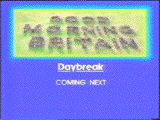 The main breakfast show’s title Good Morning Britain – a title since revived by ITV but with no connection to the TV-am original – deliberately echoed the similar US programme Good Morning America, and the British show had much in common with its American counterpart, such as the use of an on-screen clock, and the use of a caption to tell viewers what was to follow the commercial break. TV-am also made other programmes to show during its allocated time slot, such as Daybreak (the same title also used much later by ITV for its unconnected breakfast show), Data Run, and Wacaday presented by Timmy Mallet.
The main breakfast show’s title Good Morning Britain – a title since revived by ITV but with no connection to the TV-am original – deliberately echoed the similar US programme Good Morning America, and the British show had much in common with its American counterpart, such as the use of an on-screen clock, and the use of a caption to tell viewers what was to follow the commercial break. TV-am also made other programmes to show during its allocated time slot, such as Daybreak (the same title also used much later by ITV for its unconnected breakfast show), Data Run, and Wacaday presented by Timmy Mallet. After the commercial break had finished, this caption was shown, which also features the on-screen clock (showing ten past nine, in the bottom-right hand corner). By April TV-am’s future looked bleak – viewing figures had plummeted to about 100,000, partly courtesy of what was considered to be surprisingly strong competition from Breakfast Time. (Anyone remember Russell Grant’s horoscopes?) So Greg Dyke was brought in from London Weekend Television to try and improve things – David Frost was replaced by Nick Owen and TV-am went downmarket, successfully reversing the drop.
After the commercial break had finished, this caption was shown, which also features the on-screen clock (showing ten past nine, in the bottom-right hand corner). By April TV-am’s future looked bleak – viewing figures had plummeted to about 100,000, partly courtesy of what was considered to be surprisingly strong competition from Breakfast Time. (Anyone remember Russell Grant’s horoscopes?) So Greg Dyke was brought in from London Weekend Television to try and improve things – David Frost was replaced by Nick Owen and TV-am went downmarket, successfully reversing the drop.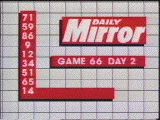 At the time there was a craze among tabloid newspapers for running bingo competitions, so a bright idea was to tell the viewers what the day’s numbers were so they didn’t have to buy the newspaper. Occasionally the numbers were misread, though any mistakes were inevitably corrected. Nick Owen bizarrely had to dress up in a beefeater’s outfit and blow a trumpet to introduce this part of the programme!
At the time there was a craze among tabloid newspapers for running bingo competitions, so a bright idea was to tell the viewers what the day’s numbers were so they didn’t have to buy the newspaper. Occasionally the numbers were misread, though any mistakes were inevitably corrected. Nick Owen bizarrely had to dress up in a beefeater’s outfit and blow a trumpet to introduce this part of the programme!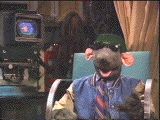 Roland Rat was also introduced as part of the April shake-up. Created by David Claridge and introduced to TV-am by Anne ‘Teletubbies’ Wood, Roland Rat proved to be very popular with the viewers and gave the breakfast start-up a much needed shot in the arm. Rat mania even spawned two UK Top 40 records in 1983/4 – Rat Rapping and Love Me Tender. Anne Diamond also had to work alongside ‘Roland Rat Superstar’ which must have been a tough act to keep up with! Thankfully Roland Rat is still very much alive today…
Roland Rat was also introduced as part of the April shake-up. Created by David Claridge and introduced to TV-am by Anne ‘Teletubbies’ Wood, Roland Rat proved to be very popular with the viewers and gave the breakfast start-up a much needed shot in the arm. Rat mania even spawned two UK Top 40 records in 1983/4 – Rat Rapping and Love Me Tender. Anne Diamond also had to work alongside ‘Roland Rat Superstar’ which must have been a tough act to keep up with! Thankfully Roland Rat is still very much alive today…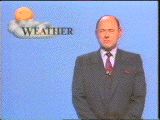 The weather forecast was presented by Commander Philpott, whose style was certainly different from the competition – come to think of it anything else past or present. ‘Stiff upper lip British’ was perhaps the best way to describe the Commander’s technique.
The weather forecast was presented by Commander Philpott, whose style was certainly different from the competition – come to think of it anything else past or present. ‘Stiff upper lip British’ was perhaps the best way to describe the Commander’s technique.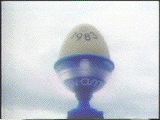 This caption was shown at the end of the programme, with one egg cup added to the picture for each year since 1983 (1984 = two egg cups displayed, etc.), though in later years only a few of the cups actually appeared in the caption. TV-am was a programme contractor in its own right, and was independent of the other companies that formed the ITV network.
This caption was shown at the end of the programme, with one egg cup added to the picture for each year since 1983 (1984 = two egg cups displayed, etc.), though in later years only a few of the cups actually appeared in the caption. TV-am was a programme contractor in its own right, and was independent of the other companies that formed the ITV network.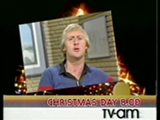 TV-am also promoted its shows at other times on the ITV network, with this example promoting Chris Tarrant and Roland Rat appearing on Christmas Day 1984 and a Princess Anne interview shown on Boxing Day.
TV-am also promoted its shows at other times on the ITV network, with this example promoting Chris Tarrant and Roland Rat appearing on Christmas Day 1984 and a Princess Anne interview shown on Boxing Day.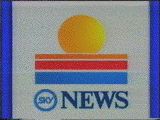 TV-am did its own news gathering in early years, but later on the news was provided by Rupert Murdoch’s Sky News until TV-am’s demise at the end of 1992.
TV-am did its own news gathering in early years, but later on the news was provided by Rupert Murdoch’s Sky News until TV-am’s demise at the end of 1992. TV-am were among the losers when the ITV broadcasting franchises were reviewed in 1991, so from the 1st January 1993 TV-am was replaced by GMTV. This picture was the very last to be transmitted by TV-am; the colour of the main scene was faded moments before the picture faded abruptly. An era had come to an end.
TV-am were among the losers when the ITV broadcasting franchises were reviewed in 1991, so from the 1st January 1993 TV-am was replaced by GMTV. This picture was the very last to be transmitted by TV-am; the colour of the main scene was faded moments before the picture faded abruptly. An era had come to an end. TV-am’s replacement, GMTV (which prior to 2004 was part-owned by Carlton, Granada and Disney) to begin with tried to establish its own identity but slowly evolved over the years into something that looks very similar to TV-am, and also provided signed news and additional cartoons on ITV2 during the same timeslot for a while under the GMTV2 banner, though (like TV-am) GMTV and ITV are technically two separate entities that just happen to use the same channel. Whilst GMTV was a separate entity from ITV, if ITV wanted to ‘borrow’ time from GMTV in order (for example) to show a sporting event, it had to compensate GMTV somehow (either financially or by giving GMTV additional air time) as a result. GMTV ceased to exist after ITV plc bought out Disney’s share of the broadcaster and what was still a physically separate commercial television franchise became fully integrated into the ITV channel as Daybreak. Later on the separate breakfast franchise was abolished by the Digital Economy Act and Daybreak has since been replaced by Good Morning Britain; nothing to do with TV-am but using the same name as TV-am’s original breakfast show.
TV-am’s replacement, GMTV (which prior to 2004 was part-owned by Carlton, Granada and Disney) to begin with tried to establish its own identity but slowly evolved over the years into something that looks very similar to TV-am, and also provided signed news and additional cartoons on ITV2 during the same timeslot for a while under the GMTV2 banner, though (like TV-am) GMTV and ITV are technically two separate entities that just happen to use the same channel. Whilst GMTV was a separate entity from ITV, if ITV wanted to ‘borrow’ time from GMTV in order (for example) to show a sporting event, it had to compensate GMTV somehow (either financially or by giving GMTV additional air time) as a result. GMTV ceased to exist after ITV plc bought out Disney’s share of the broadcaster and what was still a physically separate commercial television franchise became fully integrated into the ITV channel as Daybreak. Later on the separate breakfast franchise was abolished by the Digital Economy Act and Daybreak has since been replaced by Good Morning Britain; nothing to do with TV-am but using the same name as TV-am’s original breakfast show.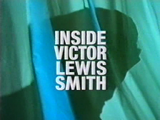 They say that restaurant critics make lousy chefs…but do television critics make lousy television? Victor Lewis-Smith is an established television critic (for the London Evening Standard) as well as writing for several other publications, and in the past Lewis-Smith had presented TV programmes such Inside Victor Lewis-Smith plus features within other shows such as BBC2’s TV Hell. His newspaper columns don’t just cover television but also nostalgia, so it’s only logical that he should also have a strong interest in television nostalgia.
They say that restaurant critics make lousy chefs…but do television critics make lousy television? Victor Lewis-Smith is an established television critic (for the London Evening Standard) as well as writing for several other publications, and in the past Lewis-Smith had presented TV programmes such Inside Victor Lewis-Smith plus features within other shows such as BBC2’s TV Hell. His newspaper columns don’t just cover television but also nostalgia, so it’s only logical that he should also have a strong interest in television nostalgia.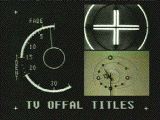
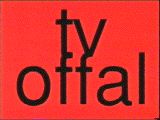
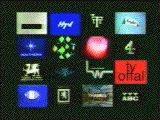 From this you might have deduced that TV Offal pokes fun not only at programmes but also at programming formats and ‘celebrities’, as well as anything else that could related to television and broadcasting culture such as test cards and ident (station identification) sequences. Despite the parodying tone, it becomes rapidly self-evident that Victor himself actually revels in these ephemera of TV culture, though it’s equally obvious that he really means it when he mocks celebrities such as Noel Edmonds or Vanessa Feltz. The audio used in the link sequences is almost uniquely (for television) styled in the form of radio jingles, notably jingles specially commissioned from the world-famous American jingle producers JAM.
From this you might have deduced that TV Offal pokes fun not only at programmes but also at programming formats and ‘celebrities’, as well as anything else that could related to television and broadcasting culture such as test cards and ident (station identification) sequences. Despite the parodying tone, it becomes rapidly self-evident that Victor himself actually revels in these ephemera of TV culture, though it’s equally obvious that he really means it when he mocks celebrities such as Noel Edmonds or Vanessa Feltz. The audio used in the link sequences is almost uniquely (for television) styled in the form of radio jingles, notably jingles specially commissioned from the world-famous American jingle producers JAM. It seemed that viewers and critics other than Victor himself liked the pilot show, so Channel 4 went ahead with commissioning a series of six half-hour programmes which ran from May 22nd 1998, shown on Friday evenings at 11 pm. Late night Channel 4 is not exactly viewing suitable for children (as programmes such as Eurotrash or The Word have graphically illustrated), so TV Offal was able to use this scheduling to its advantage in order to show the sort of things that would have made ‘clean-up tv’ campaigner Mary Whitehouse reach for the typewriter…
It seemed that viewers and critics other than Victor himself liked the pilot show, so Channel 4 went ahead with commissioning a series of six half-hour programmes which ran from May 22nd 1998, shown on Friday evenings at 11 pm. Late night Channel 4 is not exactly viewing suitable for children (as programmes such as Eurotrash or The Word have graphically illustrated), so TV Offal was able to use this scheduling to its advantage in order to show the sort of things that would have made ‘clean-up tv’ campaigner Mary Whitehouse reach for the typewriter…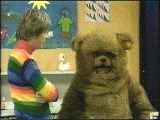 Much of the source material used by TV Offal comes from a little-known (outside of the TV industry) phenomenon known as ‘Christmas tapes’. These are unofficial compilations of programme and continuity-related material made by TV station staff in their spare time which often comprised of a collection of ‘outtakes’ (presenters fluffing their lines, etc.) compiled from such incidents recorded during the previous year but also may include clips specially recorded for the tape, originally intended for the staff’s own amusement only and not for transmission; the clip showing the Rainbow (kids’ TV show) team letting off steam with ‘the bad language’ being a prime example. The excerpt used in the pilot episode came from a Christmas 1978 tape produced by Thames Television staff.
Much of the source material used by TV Offal comes from a little-known (outside of the TV industry) phenomenon known as ‘Christmas tapes’. These are unofficial compilations of programme and continuity-related material made by TV station staff in their spare time which often comprised of a collection of ‘outtakes’ (presenters fluffing their lines, etc.) compiled from such incidents recorded during the previous year but also may include clips specially recorded for the tape, originally intended for the staff’s own amusement only and not for transmission; the clip showing the Rainbow (kids’ TV show) team letting off steam with ‘the bad language’ being a prime example. The excerpt used in the pilot episode came from a Christmas 1978 tape produced by Thames Television staff.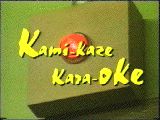 Every TV Offal featured one or two “Kamikaze Karaoke” sketches, whereby some of the most famous popular/classical music acts are seen performing, but their voices substituted with singing that is off-key/has different lyrics/etc., superimposed upon the same or similar musical backing. Guaranteed to bring the most egoistical superstar crashing down to earth, singers and acts which had been given the “This is what he sounds like to me” treatment included Pavarotti, Michael Jackson, Elvis Presley, Elton John, Bob Marley, Nigel Kennedy, Vanessa-Mae and that Manchester foursome Oasis.
Every TV Offal featured one or two “Kamikaze Karaoke” sketches, whereby some of the most famous popular/classical music acts are seen performing, but their voices substituted with singing that is off-key/has different lyrics/etc., superimposed upon the same or similar musical backing. Guaranteed to bring the most egoistical superstar crashing down to earth, singers and acts which had been given the “This is what he sounds like to me” treatment included Pavarotti, Michael Jackson, Elvis Presley, Elton John, Bob Marley, Nigel Kennedy, Vanessa-Mae and that Manchester foursome Oasis.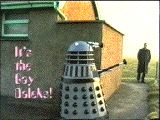 Probably the most controversial of TV Offal‘s regular features is the Gay Daleks: “They’re camp! They exterminate! Better watch your backs! It’s the Gay Daleks!” You either feel that the sketches are crude, tasteless and offensive, or they’re a splendid parody of both the Daleks and of gay cultural stereotypes; late night Channel 4 viewers (on the whole) would interpret them as the latter which is probably just as well given the content. Apparently they were popular with the gay community, though later attempts to produce a cartoon series based on the Gay Daleks did not materialise due to rights issues involving the Terry Nation estate.
Probably the most controversial of TV Offal‘s regular features is the Gay Daleks: “They’re camp! They exterminate! Better watch your backs! It’s the Gay Daleks!” You either feel that the sketches are crude, tasteless and offensive, or they’re a splendid parody of both the Daleks and of gay cultural stereotypes; late night Channel 4 viewers (on the whole) would interpret them as the latter which is probably just as well given the content. Apparently they were popular with the gay community, though later attempts to produce a cartoon series based on the Gay Daleks did not materialise due to rights issues involving the Terry Nation estate. Another semi-regular feature that straddles the commercial break is “Assassination of the Week”. This sketch parodies the voyeurism that certain programmes seem to exhibit, namely, before the commercial break an assassination attempt is shown, and viewers are invited to guess “did they live or are they worm-food?”. After the break the rest of the film is shown and the answer is given, though there was a twist when the assassination of JFK was covered. Other politicians featured included Imelda Marcos, the woman which had a very large shoe collection.
Another semi-regular feature that straddles the commercial break is “Assassination of the Week”. This sketch parodies the voyeurism that certain programmes seem to exhibit, namely, before the commercial break an assassination attempt is shown, and viewers are invited to guess “did they live or are they worm-food?”. After the break the rest of the film is shown and the answer is given, though there was a twist when the assassination of JFK was covered. Other politicians featured included Imelda Marcos, the woman which had a very large shoe collection.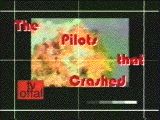 TV Offal often featured “The Pilots that Crashed”; one-off programmes that never got any further than the pilot episode or shows that had a very limited run. Perhaps controversially, the show featured “The Development of the Television Test Card” in show 2 which wasn’t a failed pilot programme; indeed it was a one-off show (made in 1985) aimed at a specialist audience as reference material therefore it was never intended to be commissioned as a broadcast series. But it featured one of Victor’s favourite subjects (as anyone seeing any earlier material of his would testify) so he couldn’t possibly ignore it!
TV Offal often featured “The Pilots that Crashed”; one-off programmes that never got any further than the pilot episode or shows that had a very limited run. Perhaps controversially, the show featured “The Development of the Television Test Card” in show 2 which wasn’t a failed pilot programme; indeed it was a one-off show (made in 1985) aimed at a specialist audience as reference material therefore it was never intended to be commissioned as a broadcast series. But it featured one of Victor’s favourite subjects (as anyone seeing any earlier material of his would testify) so he couldn’t possibly ignore it!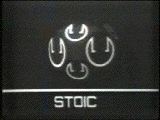 TV Offal regularly featured clips from the archives of student or hospital television stations, often featuring celebrities either before they became famous or making a guest appearence. Famous people featured included Michaela Strachan, Phillippa Forrester, and Christopher Biggins. The picture is taken from the ident used in 1969 of STOIC – Student Television of Imperial College (London).
TV Offal regularly featured clips from the archives of student or hospital television stations, often featuring celebrities either before they became famous or making a guest appearence. Famous people featured included Michaela Strachan, Phillippa Forrester, and Christopher Biggins. The picture is taken from the ident used in 1969 of STOIC – Student Television of Imperial College (London).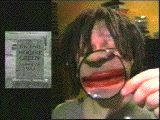 A TV Offal show wouldn’t be complete without one of Victor Lewis-Smith’s “specialities”, the wind-up phone call. He calls a famous person or organisation pretending to be someone else, with either hilarious or deeply embarrassing results. “Victims” included Carlton Television in the first show, the late Hughie Green and Mary Whitehouse. However the alleged ‘call’ to Mary Whitehouse landed Victor in a spot of bother, and it’s also interesting to note that phone calls of this nature are no longer permitted to be broadcast on UK television under Ofcom regulations.
A TV Offal show wouldn’t be complete without one of Victor Lewis-Smith’s “specialities”, the wind-up phone call. He calls a famous person or organisation pretending to be someone else, with either hilarious or deeply embarrassing results. “Victims” included Carlton Television in the first show, the late Hughie Green and Mary Whitehouse. However the alleged ‘call’ to Mary Whitehouse landed Victor in a spot of bother, and it’s also interesting to note that phone calls of this nature are no longer permitted to be broadcast on UK television under Ofcom regulations. The show is produced by Victor’s own production company, Associated-Rediffusion Television Ltd., which happens also to be the name of the ITV contractor that served London weekdays from 1955-1968. Victor bought the rights many years ago when it was simply ‘gathering dust’, and he even featured the voice of Redvers Kyle who was a regular continuity announcer for A-R in the 1950s (amongst others), in show 4. There will never be a commercial release (DVD/video download, etc.) of the TV Offal series because producer John Warburton found it difficult enough gaining copyright clearance for many of the clips used simply for television transmission.
The show is produced by Victor’s own production company, Associated-Rediffusion Television Ltd., which happens also to be the name of the ITV contractor that served London weekdays from 1955-1968. Victor bought the rights many years ago when it was simply ‘gathering dust’, and he even featured the voice of Redvers Kyle who was a regular continuity announcer for A-R in the 1950s (amongst others), in show 4. There will never be a commercial release (DVD/video download, etc.) of the TV Offal series because producer John Warburton found it difficult enough gaining copyright clearance for many of the clips used simply for television transmission.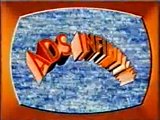 So, to paraphrase the “Assassination of the Week” feature, what happened next? The answer is the cleverly-titled Ads Infinitum – two series of ten-minute programmes shown on BBC2 (the first series in 1998), which (as the title suggests) are all about television or cinema adverts. And as for TV Offal itself, the only repeat showings were some compilation programmes (‘the best of’ or ‘the worst of’, depending on your point of view.) subsequently shown on Channel 4. These days Victor Lewis-Smith is occasionally still involved with television production and continues to be a newspaper TV critic and columnist for publications such as Private Eye; recent productions include Alchemists of Sound for BBC Four, You’re Fayed! for Channel 4 and a documentary The Undiscovered Peter Cook for BBC Four featuring some of the satirist’s personal diaries, letters, photographs and recordings.
So, to paraphrase the “Assassination of the Week” feature, what happened next? The answer is the cleverly-titled Ads Infinitum – two series of ten-minute programmes shown on BBC2 (the first series in 1998), which (as the title suggests) are all about television or cinema adverts. And as for TV Offal itself, the only repeat showings were some compilation programmes (‘the best of’ or ‘the worst of’, depending on your point of view.) subsequently shown on Channel 4. These days Victor Lewis-Smith is occasionally still involved with television production and continues to be a newspaper TV critic and columnist for publications such as Private Eye; recent productions include Alchemists of Sound for BBC Four, You’re Fayed! for Channel 4 and a documentary The Undiscovered Peter Cook for BBC Four featuring some of the satirist’s personal diaries, letters, photographs and recordings.
 In the days before remote controls you had to get out of your seat to make any adjustments to the television set such as adjusting the volume or changing the channel, etc., with the earliest televisions often only being capable of receiving one or two TV channels that were pre-defined for a particular transmitter by the supplying dealer if not done so at the factory.
In the days before remote controls you had to get out of your seat to make any adjustments to the television set such as adjusting the volume or changing the channel, etc., with the earliest televisions often only being capable of receiving one or two TV channels that were pre-defined for a particular transmitter by the supplying dealer if not done so at the factory. These manual controls often had a great tactile feel to them, especially the VHF channel selector which usually clicked when the knob was turned, and there were numerous other controls for picture adjustment (usually concealed at the sides or rear) which occasionally had to be adjusted due to valve-based circuitry drifting out of alignment, hence the importance of the test card and tuning signal broadcasts prior to the 1980s because they were used to correctly set up a television receiver.
These manual controls often had a great tactile feel to them, especially the VHF channel selector which usually clicked when the knob was turned, and there were numerous other controls for picture adjustment (usually concealed at the sides or rear) which occasionally had to be adjusted due to valve-based circuitry drifting out of alignment, hence the importance of the test card and tuning signal broadcasts prior to the 1980s because they were used to correctly set up a television receiver.


 So what were the shops that sold televisions like in the 1950s? The pictures above show a typical example – this was the era before the advent of the big superstore, so lots of receivers were packed into a relatively small shop space (though some department stores also sold televisions, of course). The brand names are mainly unfamiliar, and there’s a complete absence of anything resembling a video recorder. Only one set is showing a picture, and it is Test Card C which was a very common daytime sight in this period.
So what were the shops that sold televisions like in the 1950s? The pictures above show a typical example – this was the era before the advent of the big superstore, so lots of receivers were packed into a relatively small shop space (though some department stores also sold televisions, of course). The brand names are mainly unfamiliar, and there’s a complete absence of anything resembling a video recorder. Only one set is showing a picture, and it is Test Card C which was a very common daytime sight in this period. The dawn of commercial television (ITV) in 1955 – TV shops in the London and Midlands had signs like this one in the window as retailers promoted the forthcoming ITV service.
The dawn of commercial television (ITV) in 1955 – TV shops in the London and Midlands had signs like this one in the window as retailers promoted the forthcoming ITV service. If you already had a TV set and wanted ITV as well…prepare to be converted – at a price, of course. In front is a card promoting Ferguson TV’s. “Fine sets those Ferguson’s” was the slogan used at the time.
If you already had a TV set and wanted ITV as well…prepare to be converted – at a price, of course. In front is a card promoting Ferguson TV’s. “Fine sets those Ferguson’s” was the slogan used at the time. And talking of Ferguson, here’s a selection of Ferguson TV’s and radio’s from the mid 1950s. Ferguson were taken over by the Thorn-EMI empire, which then sold the brand to Thomson (100% owned by the French government), though Thomson has now ceased to exist in the UK. Brands like Alba, Bush and Murphy are now the preserve of retailers and mail order catalogues who basically just use the name for their own-branded products.
And talking of Ferguson, here’s a selection of Ferguson TV’s and radio’s from the mid 1950s. Ferguson were taken over by the Thorn-EMI empire, which then sold the brand to Thomson (100% owned by the French government), though Thomson has now ceased to exist in the UK. Brands like Alba, Bush and Murphy are now the preserve of retailers and mail order catalogues who basically just use the name for their own-branded products. There were many more brands of television prior to the 1980s, most of which have long since disappeared altogether or absorbed into multinational companies. Here is a picture of the innards of an Ekco television of the mid 1950s.
There were many more brands of television prior to the 1980s, most of which have long since disappeared altogether or absorbed into multinational companies. Here is a picture of the innards of an Ekco television of the mid 1950s. Moving forward ten years to 1965, and the introduction of one of the first ‘affordable’ video tape recording machines – the Philips EL3400. It was bulky and used an exposed reel of tape, plus it only recorded in black and white despite colour transmissions being available not long afterwards. It also had no tuner or timer facility, so it was only useful with (sometimes) expensive external ancillary equipment such as a separate television tuner or video camera. However, two years before the EL3400 there was a British recorder advertised for sale called the Telcan that was possibly the world’s first domestic video recorder. It could record approximately 20 minutes of 405 line video and audio onto audio tape; a remarkable feat for relatively primitive technology but was a commercial failure presumably due to the short length of its recordings. Only two examples of the Telcan are known to exist nowadays.
Moving forward ten years to 1965, and the introduction of one of the first ‘affordable’ video tape recording machines – the Philips EL3400. It was bulky and used an exposed reel of tape, plus it only recorded in black and white despite colour transmissions being available not long afterwards. It also had no tuner or timer facility, so it was only useful with (sometimes) expensive external ancillary equipment such as a separate television tuner or video camera. However, two years before the EL3400 there was a British recorder advertised for sale called the Telcan that was possibly the world’s first domestic video recorder. It could record approximately 20 minutes of 405 line video and audio onto audio tape; a remarkable feat for relatively primitive technology but was a commercial failure presumably due to the short length of its recordings. Only two examples of the Telcan are known to exist nowadays. Compared to the Telcan, the EL3400 was a greater success and certainly had its uses, as a group of dancers watch themselves perform on a large video projection screen. The EL3400 did not come cheap because it used a helical scan recording technique also used by professional recorders like the Ampex Quadraplex (the world’s first broadcast quality video recorder), so it was typically found only in large education establishments or used for industrial applications. Also Japanese companies such as Shibaden and Sony were starting to make their presence felt at this time with recorders like the CV-2000 format reel to reel machines which were soon followed by the U-Matic video cassette that proved popular in the industrial and commercial markets.
Compared to the Telcan, the EL3400 was a greater success and certainly had its uses, as a group of dancers watch themselves perform on a large video projection screen. The EL3400 did not come cheap because it used a helical scan recording technique also used by professional recorders like the Ampex Quadraplex (the world’s first broadcast quality video recorder), so it was typically found only in large education establishments or used for industrial applications. Also Japanese companies such as Shibaden and Sony were starting to make their presence felt at this time with recorders like the CV-2000 format reel to reel machines which were soon followed by the U-Matic video cassette that proved popular in the industrial and commercial markets. The common face of television in the mid to late 1960s – black and white, dual standard (though lots of single-standard 405 line VHF-only televisions remained in use for many years) with separate controls for 405-line VHF and 625-line UHF transmissions. This was required since from 1964 the new BBC2 service was only available on UHF.
The common face of television in the mid to late 1960s – black and white, dual standard (though lots of single-standard 405 line VHF-only televisions remained in use for many years) with separate controls for 405-line VHF and 625-line UHF transmissions. This was required since from 1964 the new BBC2 service was only available on UHF. 1967 saw the arrival of the first mass produced colour TV’s for the UK market, though their high price and initial lack of colour programming (BBC2 only until 1969, few transmitters provided a colour signal and not all programmes were in colour) ensured slow sales to begin with. The picture shows an HMV Colourmaster which was typical of the sets produced in the late 1960s. Find out more about early colour television on the Colour Television page.
1967 saw the arrival of the first mass produced colour TV’s for the UK market, though their high price and initial lack of colour programming (BBC2 only until 1969, few transmitters provided a colour signal and not all programmes were in colour) ensured slow sales to begin with. The picture shows an HMV Colourmaster which was typical of the sets produced in the late 1960s. Find out more about early colour television on the Colour Television page. Fast forward to 1972 – though a few lucky buyers may have had access to one in 1971 – and the launch of the first ‘proper’ ‘home’ video recorder with an integrated tuner and timer, the Philips N1500. This close-up view (disregard the Sony machine just visible) shows the sloping front panel with (from left to right) a recording level meter, tape transport controls, and the 1 day, 1 event ‘egg timer’ clock. Each large Philips VCR cassette could record up to 30 or 60 (later 80) minutes; the six channel selector buttons are visible above the transport controls. The only thing to put off a potential purchaser – apart from the relatively short running time – was the steep price tag. However the N1500 was not generally available until the end of 1973; earlier it was only sold to schools and corporate customers, and these customers remained the main purchasers of such an expensive device. The less than 90 minutes maximum recording time would have limited its appeal to wealthy people who weren’t interested in recording long movies, therefore it tended to be only specialist shops and upmarket department stores that stocked the recorder.
Fast forward to 1972 – though a few lucky buyers may have had access to one in 1971 – and the launch of the first ‘proper’ ‘home’ video recorder with an integrated tuner and timer, the Philips N1500. This close-up view (disregard the Sony machine just visible) shows the sloping front panel with (from left to right) a recording level meter, tape transport controls, and the 1 day, 1 event ‘egg timer’ clock. Each large Philips VCR cassette could record up to 30 or 60 (later 80) minutes; the six channel selector buttons are visible above the transport controls. The only thing to put off a potential purchaser – apart from the relatively short running time – was the steep price tag. However the N1500 was not generally available until the end of 1973; earlier it was only sold to schools and corporate customers, and these customers remained the main purchasers of such an expensive device. The less than 90 minutes maximum recording time would have limited its appeal to wealthy people who weren’t interested in recording long movies, therefore it tended to be only specialist shops and upmarket department stores that stocked the recorder.





 CEEFAX had been demonstrated by the BBC to the public as early as a news report on 23 October 1972, but IBA engineers had been independently working on their own ORACLE system therefore it took two years for the two incompatible systems to be reworked into a single standard known as teletext and for broadcasts to commence, with the acronyms CEEFAX and ORACLE being used as the two brand names for the BBC and IBA (ITV) services using the same teletext standard. The falling price of digital electronics made teletext much more affordable during the 1980s and proved to be popular in the UK, remaining in use until it was made obsolete by the analogue TV transmission switch off.
CEEFAX had been demonstrated by the BBC to the public as early as a news report on 23 October 1972, but IBA engineers had been independently working on their own ORACLE system therefore it took two years for the two incompatible systems to be reworked into a single standard known as teletext and for broadcasts to commence, with the acronyms CEEFAX and ORACLE being used as the two brand names for the BBC and IBA (ITV) services using the same teletext standard. The falling price of digital electronics made teletext much more affordable during the 1980s and proved to be popular in the UK, remaining in use until it was made obsolete by the analogue TV transmission switch off.



 Before the video cassette recorder (VCR) became popular during the 1980s, it was necessary to explain to potential customers exactly what a VCR was and what it could actually do, and those potential customers may not be mechanically-minded either, so the best person to explain what a VCR did in layman’s terms is someone who is recognisably an expert in television but who isn’t necessarily an expert in things mechanical, namely someone like the writer and presenter Denis Norden, therefore Philips were extremely lucky to be able to have Norden present their promotional video demonstrating the benefits of their brand new N1700 VCR. It’s interesting that Philips chose to describe their VCR as simply a “Time Machine” as opposed to a “Television Time Machine” which would have been a much more precise description of what it could do if perhaps a less eye-catching expression.
Before the video cassette recorder (VCR) became popular during the 1980s, it was necessary to explain to potential customers exactly what a VCR was and what it could actually do, and those potential customers may not be mechanically-minded either, so the best person to explain what a VCR did in layman’s terms is someone who is recognisably an expert in television but who isn’t necessarily an expert in things mechanical, namely someone like the writer and presenter Denis Norden, therefore Philips were extremely lucky to be able to have Norden present their promotional video demonstrating the benefits of their brand new N1700 VCR. It’s interesting that Philips chose to describe their VCR as simply a “Time Machine” as opposed to a “Television Time Machine” which would have been a much more precise description of what it could do if perhaps a less eye-catching expression. The N1700 recorded television broadcasts onto the same size cassette tapes as the N1500, with up to 2 hours of record and play time initially available (Long Play = LP) compared to the 1 hour duration offered by the earlier N1500 series machines (including the N1502 which looked very similar to the N1700); this was achieved by slowing the tape speed down and using improved electronics, therefore recordings were incompatible between VCR-LP and the earlier VCR machines. Even longer tapes were later introduced, enabling 3 hours of recording time on VCR-LP recorders in order to compete with the new VHS and Betamax recorders offered by Japanese manufacturers that were launched in the UK during 1978. (Betamax and VHS had already launched in Japanese/US NTSC markets; 1975 for Betamax and 1976 for VHS respectively, so Philips knew that competition for their product was soon to appear in Europe.)
The N1700 recorded television broadcasts onto the same size cassette tapes as the N1500, with up to 2 hours of record and play time initially available (Long Play = LP) compared to the 1 hour duration offered by the earlier N1500 series machines (including the N1502 which looked very similar to the N1700); this was achieved by slowing the tape speed down and using improved electronics, therefore recordings were incompatible between VCR-LP and the earlier VCR machines. Even longer tapes were later introduced, enabling 3 hours of recording time on VCR-LP recorders in order to compete with the new VHS and Betamax recorders offered by Japanese manufacturers that were launched in the UK during 1978. (Betamax and VHS had already launched in Japanese/US NTSC markets; 1975 for Betamax and 1976 for VHS respectively, so Philips knew that competition for their product was soon to appear in Europe.)



 Just like the earlier N1500/N1502 models, the N1700 VCR recorded television broadcasts onto removable cassette tapes, therefore you had to have inserted a tape into the machine in the first place and ensured that there was enough free space on the tape for a new recording, if necessary rewinding the tape to a suitable point (or the beginning) as shown here, but anyone already familiar with audio cassette recording as most people were at that point during the 1970s would instinctively understand such concepts even if people under the age of 25 nowadays would be even more clueless about VCR’s as the average person would have been in the 1970s. The N1700 did the job it was designed to do on a basic level, but it had no remote control and no picture search facility so you had to make use of a mechanical tape counter and/or the tape compartment window to work out exactly how much tape was left for recording/playback.
Just like the earlier N1500/N1502 models, the N1700 VCR recorded television broadcasts onto removable cassette tapes, therefore you had to have inserted a tape into the machine in the first place and ensured that there was enough free space on the tape for a new recording, if necessary rewinding the tape to a suitable point (or the beginning) as shown here, but anyone already familiar with audio cassette recording as most people were at that point during the 1970s would instinctively understand such concepts even if people under the age of 25 nowadays would be even more clueless about VCR’s as the average person would have been in the 1970s. The N1700 did the job it was designed to do on a basic level, but it had no remote control and no picture search facility so you had to make use of a mechanical tape counter and/or the tape compartment window to work out exactly how much tape was left for recording/playback. The N1700 did have a basic digital timer capable of recording one programme that had a start time at some point during the next three days, which at least was an improvement over the first Philips VCR N1500 that could only manage a recording start time during the next 24 hours (and was a mechanical timer similar to that used on an old cooker); the N1700 timer was set using a sliding control which was moved one step at a time from left to right, setting the day, start time, and programme duration in that order. Simple and relatively foolproof if not the last word in sophistication, but anything more complex would have made the N1700 too expensive when Philips was trying to keep the overall product cost down.
The N1700 did have a basic digital timer capable of recording one programme that had a start time at some point during the next three days, which at least was an improvement over the first Philips VCR N1500 that could only manage a recording start time during the next 24 hours (and was a mechanical timer similar to that used on an old cooker); the N1700 timer was set using a sliding control which was moved one step at a time from left to right, setting the day, start time, and programme duration in that order. Simple and relatively foolproof if not the last word in sophistication, but anything more complex would have made the N1700 too expensive when Philips was trying to keep the overall product cost down. If you were really wealthy in the 1970s, you could not only afford a VCR but also have the disposable income to buy an optional camera to plug in the back of it, meaning that you could record home movies on your VCR as long as the lead between camera and VCR was long enough to reach where you wanted to record; fine for recording children playing in the living room or perhaps in the garden from the patio but useless for many other parts of the house or outside. Also the cheap cameras only recorded in black and white, therefore colour recording required additional expense as well as good lighting because the camera tubes weren’t very sensitive to light, so that candlelit dinner party recording may turn out to be a complete washout unless very bright lights were used.
If you were really wealthy in the 1970s, you could not only afford a VCR but also have the disposable income to buy an optional camera to plug in the back of it, meaning that you could record home movies on your VCR as long as the lead between camera and VCR was long enough to reach where you wanted to record; fine for recording children playing in the living room or perhaps in the garden from the patio but useless for many other parts of the house or outside. Also the cheap cameras only recorded in black and white, therefore colour recording required additional expense as well as good lighting because the camera tubes weren’t very sensitive to light, so that candlelit dinner party recording may turn out to be a complete washout unless very bright lights were used.






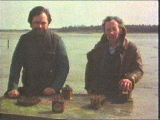 Ever wondered how everyday home appliances such as a fridge, fax machine, or central heating operated? Even if you hadn’t, The Secret Life of Machines series set out to explain simply and clearly how these (and more) items perform their functions. Presented by Tim Hunkin (right) and Rex Garrod, three series of programmes were produced for Channel 4 in 1988, 1991 and 1993 (the third series was entitled The Secret Life of the Office); all pictures shown here are taken from The Secret Life of the Television Set which was the last programme in the first series. Other programmes have since been produced that have names prefixed with “The Secret Life of…” (e.g. The Secret Life of the Zoo), but they are unrelated to The Secret Life of Machines/The Secret Life of the Office.
Ever wondered how everyday home appliances such as a fridge, fax machine, or central heating operated? Even if you hadn’t, The Secret Life of Machines series set out to explain simply and clearly how these (and more) items perform their functions. Presented by Tim Hunkin (right) and Rex Garrod, three series of programmes were produced for Channel 4 in 1988, 1991 and 1993 (the third series was entitled The Secret Life of the Office); all pictures shown here are taken from The Secret Life of the Television Set which was the last programme in the first series. Other programmes have since been produced that have names prefixed with “The Secret Life of…” (e.g. The Secret Life of the Zoo), but they are unrelated to The Secret Life of Machines/The Secret Life of the Office. A special feature is the use of (often humourous) cartoons that are used to illustrate ‘moments in history’ which are relevant to the appliance under discussion. This picture is taken from a cartoon used to show the moment when it was discovered that selenium can cause an electrical voltage to change dependent on the amount of light shining on it.
A special feature is the use of (often humourous) cartoons that are used to illustrate ‘moments in history’ which are relevant to the appliance under discussion. This picture is taken from a cartoon used to show the moment when it was discovered that selenium can cause an electrical voltage to change dependent on the amount of light shining on it. Tim Hunkin (the main presenter and architect of the series) may look exactly like the stereotypical image of “the professor”, but contrary to this he presents technology in a very straightforward and easy to understand manner and manages to do so in a way that can keep the interest of both novices and experts alike. His secret is possibly that if you’re not afraid of technology and you understand how an item works you can “deconstruct” an item into its various simpler components, and also avoiding unneccesary complexity when explaining how something operates.
Tim Hunkin (the main presenter and architect of the series) may look exactly like the stereotypical image of “the professor”, but contrary to this he presents technology in a very straightforward and easy to understand manner and manages to do so in a way that can keep the interest of both novices and experts alike. His secret is possibly that if you’re not afraid of technology and you understand how an item works you can “deconstruct” an item into its various simpler components, and also avoiding unneccesary complexity when explaining how something operates.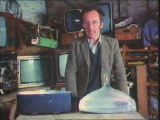 So how did Tim get into television? After gaining a Cambridge degree, he took on a series of bizarre commissions ranging from firework displays to mechanical sculptures. Back in 1972 he had drawn some cartoons for the Cambridge University newspaper Stop Press (the first one was about drawing cows!); this lead to a whole series of witty and factual cartoons for the Sunday Observer magazine colour supplement from 1973 to 1987 entitled “The Rudiments of Wisdom”, covering everything from acids to zoos (they were republished later in a book). Anticipating change at The Observer, Tim developed a proposal for a television series and his agent sent it to Channel 4. The rest, as they say, is history.
So how did Tim get into television? After gaining a Cambridge degree, he took on a series of bizarre commissions ranging from firework displays to mechanical sculptures. Back in 1972 he had drawn some cartoons for the Cambridge University newspaper Stop Press (the first one was about drawing cows!); this lead to a whole series of witty and factual cartoons for the Sunday Observer magazine colour supplement from 1973 to 1987 entitled “The Rudiments of Wisdom”, covering everything from acids to zoos (they were republished later in a book). Anticipating change at The Observer, Tim developed a proposal for a television series and his agent sent it to Channel 4. The rest, as they say, is history. Don’t try this at home kids! (Or for that matter, adults as well!) Who else would probably construct their own plasma lamp using the high voltage line output transformer from an old television set?
Don’t try this at home kids! (Or for that matter, adults as well!) Who else would probably construct their own plasma lamp using the high voltage line output transformer from an old television set?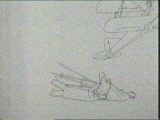 Humour can help make something more memorable, as many academic lecturers are sometimes keen to point out. A cartoon showing that the electronic-scanning Marconi-EMI system cameras (as opposed to the large fixed-position Baird mechanical scanning cameras) were much more versatile by showing someone using one to record a flying aircraft, and then showing the poor camerman being knocked over by the low-flying aircraft!
Humour can help make something more memorable, as many academic lecturers are sometimes keen to point out. A cartoon showing that the electronic-scanning Marconi-EMI system cameras (as opposed to the large fixed-position Baird mechanical scanning cameras) were much more versatile by showing someone using one to record a flying aircraft, and then showing the poor camerman being knocked over by the low-flying aircraft!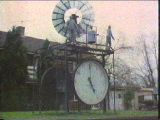 So what do Tim and Rex do when they’re not making television programmes? Well they make models and other mechanical devices for various organisations such as exhibitions and television programmes, and these were often featured to illustrate concepts throughout the series. This wind-powered mechanical clock was developed for the Liverpool Garden Festival some years ago.
So what do Tim and Rex do when they’re not making television programmes? Well they make models and other mechanical devices for various organisations such as exhibitions and television programmes, and these were often featured to illustrate concepts throughout the series. This wind-powered mechanical clock was developed for the Liverpool Garden Festival some years ago.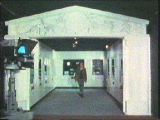 Tim Hunkin also designs and builds a lot of those ‘hands-on’ museum exhibits that interact in some way with the visitor; he designed this section for the National Museum of Photography, Film and Television in Bradford, Yorkshire. Amongst other commissions he has also developed for the Science Museum in London.
Tim Hunkin also designs and builds a lot of those ‘hands-on’ museum exhibits that interact in some way with the visitor; he designed this section for the National Museum of Photography, Film and Television in Bradford, Yorkshire. Amongst other commissions he has also developed for the Science Museum in London.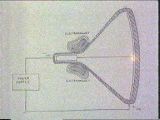 Here is an example of a display from the Bradford museum, showing how an electron beam generates a spot of light when it hits the phosphor-coated front surface of the cathode-ray tube.
Here is an example of a display from the Bradford museum, showing how an electron beam generates a spot of light when it hits the phosphor-coated front surface of the cathode-ray tube.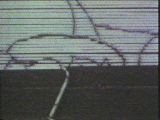 Tim and Rex are not afraid of using anything unusual to illustrate something that they are trying to explain – here they are using string with ink dots on it to illustrate how a television picture in constructed using scanning lines and dots of varying brightness.
Tim and Rex are not afraid of using anything unusual to illustrate something that they are trying to explain – here they are using string with ink dots on it to illustrate how a television picture in constructed using scanning lines and dots of varying brightness.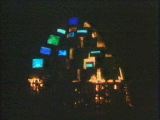 To conclude the first series they built an amazing funeral pyre consisting of old television sets which were faulty in some way but were not worth repairing. The stack of sets were all switched on when the flames were lit, and as the end credits rolled the TV screens flickered and died in turn as the flames rose higher and higher. However it has now been revealed that they wrongly thought the end credits would be less than a minute long therefore the fire was designed to burn quickly, meaning that they had to make the most out of using a relatively small quantity of film footage.
To conclude the first series they built an amazing funeral pyre consisting of old television sets which were faulty in some way but were not worth repairing. The stack of sets were all switched on when the flames were lit, and as the end credits rolled the TV screens flickered and died in turn as the flames rose higher and higher. However it has now been revealed that they wrongly thought the end credits would be less than a minute long therefore the fire was designed to burn quickly, meaning that they had to make the most out of using a relatively small quantity of film footage.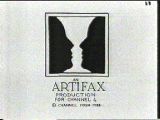 The programmes were mainly Tim Hunkin’s own work, though he had assistants to help him with various tasks such as production. Tim feels that although the shows were popular there was a danger that they were becoming “too formula-based”, so there are no further plans for any more “Secret Life” programmes – however in 1998 he planned to develop a TV series about photography which unfortunately didn’t materialise. Meanwhile he has numerous projects to keep him occupied; he gave a Science Museum talk entitled “Illegal Engineering” which was all about security and safe-cracking, and recent commissions include a Pirate Practice arcade machine installed at Southend Pier in 2012. He also has a “mad arcade of home-made machines & simulator rides” at Southwold Pier in Suffolk entitled “The Under The Pier Show” as well as machines at Novelty Automation based in London. Rex was last seen on the programme Robot Wars as part of a team which lost in a final.
The programmes were mainly Tim Hunkin’s own work, though he had assistants to help him with various tasks such as production. Tim feels that although the shows were popular there was a danger that they were becoming “too formula-based”, so there are no further plans for any more “Secret Life” programmes – however in 1998 he planned to develop a TV series about photography which unfortunately didn’t materialise. Meanwhile he has numerous projects to keep him occupied; he gave a Science Museum talk entitled “Illegal Engineering” which was all about security and safe-cracking, and recent commissions include a Pirate Practice arcade machine installed at Southend Pier in 2012. He also has a “mad arcade of home-made machines & simulator rides” at Southwold Pier in Suffolk entitled “The Under The Pier Show” as well as machines at Novelty Automation based in London. Rex was last seen on the programme Robot Wars as part of a team which lost in a final.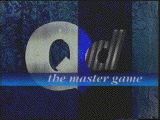 Over the years there have been many varieties of quiz show, from the intellectual (such as Call My Bluff) to the unashamedly populist Play Your Cards Right. QD: The Master Game was fundamentally similar to shows such as the mid-1980s TVS-produced Ultra Quiz, though it also had an affinity with the more intellectual shows. To briefly summarise – over five half-hour programmes (shown Monday to Friday on Channel 4 in 1991) an initially large number of contestants take part in a series of intellectual challenges; the number of contestants are reduced through elimination to a more manageable number for the final stages.
Over the years there have been many varieties of quiz show, from the intellectual (such as Call My Bluff) to the unashamedly populist Play Your Cards Right. QD: The Master Game was fundamentally similar to shows such as the mid-1980s TVS-produced Ultra Quiz, though it also had an affinity with the more intellectual shows. To briefly summarise – over five half-hour programmes (shown Monday to Friday on Channel 4 in 1991) an initially large number of contestants take part in a series of intellectual challenges; the number of contestants are reduced through elimination to a more manageable number for the final stages.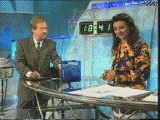 So what exactly did QD stand for, apart from yet another quiz game? An ongoing competition that took place during the five days when QD: The Master Game was shown was for viewers to guess what QD stood for, with the answer being revealed on Friday. To guess this one required knowledge of Latin and/or access to a Latin dictionary, since QD was an abbreviation for the Latin ‘quinque dies’ (or five days) – though if QD had reminded you of the famous abbreviation QED (quod erat demonstratum) you were probably half way there! This illustrates clearly that QD was not going to be just another ordinary quiz show.
So what exactly did QD stand for, apart from yet another quiz game? An ongoing competition that took place during the five days when QD: The Master Game was shown was for viewers to guess what QD stood for, with the answer being revealed on Friday. To guess this one required knowledge of Latin and/or access to a Latin dictionary, since QD was an abbreviation for the Latin ‘quinque dies’ (or five days) – though if QD had reminded you of the famous abbreviation QED (quod erat demonstratum) you were probably half way there! This illustrates clearly that QD was not going to be just another ordinary quiz show.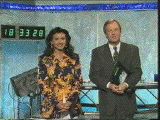 The presenters were the experienced Tim Brooke-Taylor (who was one of the Goodies – a popular BBC comedy show of the 1970s) and Lisa Aziz, who was the daughter of Khalid Aziz (he was a presenter who had worked for TVS, the ITV company who had also coincidentally produced Ultra Quiz). It seemed obvious that QD: The Master Game‘s format had been influenced by shows like The Krypton Factor along with the aforementioned Ultra Quiz.
The presenters were the experienced Tim Brooke-Taylor (who was one of the Goodies – a popular BBC comedy show of the 1970s) and Lisa Aziz, who was the daughter of Khalid Aziz (he was a presenter who had worked for TVS, the ITV company who had also coincidentally produced Ultra Quiz). It seemed obvious that QD: The Master Game‘s format had been influenced by shows like The Krypton Factor along with the aforementioned Ultra Quiz.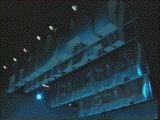 The studio set was fairly elaborate and must have cost quite a lot of time and money to construct (Noel Gay Productions must have been confident of QD being commissioned as a full series). This view of the studio gantry shows the large signs showing the days of the week: the appropriate one being lowered into view. The show also used video effects heavily, with captions spinning into view and an elaborate title sequence (which unfortunately we don’t have in its full form).
The studio set was fairly elaborate and must have cost quite a lot of time and money to construct (Noel Gay Productions must have been confident of QD being commissioned as a full series). This view of the studio gantry shows the large signs showing the days of the week: the appropriate one being lowered into view. The show also used video effects heavily, with captions spinning into view and an elaborate title sequence (which unfortunately we don’t have in its full form). By Friday (the show from which all of these pictures were taken) the number of contestants had been reduced to six, and all of them remained ‘in play’ in order to decide which person was to receive the £5000 prize.
By Friday (the show from which all of these pictures were taken) the number of contestants had been reduced to six, and all of them remained ‘in play’ in order to decide which person was to receive the £5000 prize.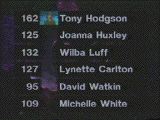 The person with the highest score at the start of Friday’s play (Tony Hodgson) was rarely troubled during the show and went on to win the final prize, though the prize for the contestant who was the most popular with the studio audience had to go to Wilba Luff, who was extrovert yet likeable (Wilba incidentally is a nickname for William). Simply mentioning his name provoked cheers and yelps from the audience; indeed the very concept of “getting to know the contestants” is very much a part of modern ‘reality’ TV formats and QD: The Master Game along with Ultra Quiz employed an “emotional journey” factor as part of their appeal years before programmes like Pop Idol were shown.
The person with the highest score at the start of Friday’s play (Tony Hodgson) was rarely troubled during the show and went on to win the final prize, though the prize for the contestant who was the most popular with the studio audience had to go to Wilba Luff, who was extrovert yet likeable (Wilba incidentally is a nickname for William). Simply mentioning his name provoked cheers and yelps from the audience; indeed the very concept of “getting to know the contestants” is very much a part of modern ‘reality’ TV formats and QD: The Master Game along with Ultra Quiz employed an “emotional journey” factor as part of their appeal years before programmes like Pop Idol were shown.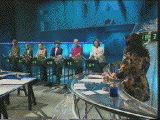 Fingers on buzzers! The challenges were a mixture of practical tests (see below) and general knowledge/memory tests; one which featured in Friday’s show was that the contestants had to try to memorise the contents of a book full of abbreviations – they were then tested on how much of the book they had actually remembered, though in this case some of the questions could be answered if you had good general knowledge skills. An example question: What does IMF stand for? (Answer: International Monetary Fund.)
Fingers on buzzers! The challenges were a mixture of practical tests (see below) and general knowledge/memory tests; one which featured in Friday’s show was that the contestants had to try to memorise the contents of a book full of abbreviations – they were then tested on how much of the book they had actually remembered, though in this case some of the questions could be answered if you had good general knowledge skills. An example question: What does IMF stand for? (Answer: International Monetary Fund.)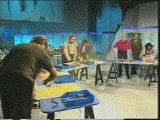 One of the ongoing challenges during the week was for the contestants to design a graphic logo which incorporated QD and the European flag symbol. No prizes for guessing who won this round…the others sadly didn’t stand much of a chance!
One of the ongoing challenges during the week was for the contestants to design a graphic logo which incorporated QD and the European flag symbol. No prizes for guessing who won this round…the others sadly didn’t stand much of a chance!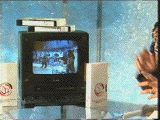 There must be at least six video copies of QD in existence, since the ‘losers’ (and I’m assuming Tony Hodgson as well) received a video cassette of the entire week’s programmes. The runners-up also each received this neat-looking 10″ television/video combination to play it on. Tony (to win the £5000) then had to answer 30 questions (based on all that he had done during the five days) in three minutes, which he did – but only just.
There must be at least six video copies of QD in existence, since the ‘losers’ (and I’m assuming Tony Hodgson as well) received a video cassette of the entire week’s programmes. The runners-up also each received this neat-looking 10″ television/video combination to play it on. Tony (to win the £5000) then had to answer 30 questions (based on all that he had done during the five days) in three minutes, which he did – but only just.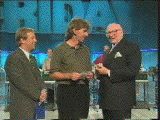 Tony Hodgson (centre) received his cheque for £5000 at the end – he was asked how he would spend the money. He replied that he would possibly buy a computer for educational purposes for his family (sensible chap that he is). We’ve worked out that at the time his options would have been either a 66 MHz 486 DX/2 PC or Apple Mac Quadra 900 4/160 (the latter leaving no change from £4095, and little change for extras such as a single-speed CD-ROM). Overall the general feeling was that both the contestants, the studio audience, and (hopefully) the viewers had enjoyed these five days in 1991.
Tony Hodgson (centre) received his cheque for £5000 at the end – he was asked how he would spend the money. He replied that he would possibly buy a computer for educational purposes for his family (sensible chap that he is). We’ve worked out that at the time his options would have been either a 66 MHz 486 DX/2 PC or Apple Mac Quadra 900 4/160 (the latter leaving no change from £4095, and little change for extras such as a single-speed CD-ROM). Overall the general feeling was that both the contestants, the studio audience, and (hopefully) the viewers had enjoyed these five days in 1991.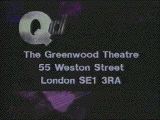 Despite the enthusiasm shown for the pilot, Channel 4 did not commission a full series; the official reason given (according to Tim Brooke-Taylor) was that it would have cost too much. Unofficially its demise may have been down to simply the fact that the relevant commissioning editor wasn’t too keen on the idea in the first place – it was Bill Cotton who came up with the idea, and his friend Michael Grade just happened to be head of Channel 4. QED. Tim also said that “I loved the scary week and cannot speak highly enough of the contestants and the production team. I also have a copy and am proud of the whole thing. But don’t ask me about commissioning editors.”
Despite the enthusiasm shown for the pilot, Channel 4 did not commission a full series; the official reason given (according to Tim Brooke-Taylor) was that it would have cost too much. Unofficially its demise may have been down to simply the fact that the relevant commissioning editor wasn’t too keen on the idea in the first place – it was Bill Cotton who came up with the idea, and his friend Michael Grade just happened to be head of Channel 4. QED. Tim also said that “I loved the scary week and cannot speak highly enough of the contestants and the production team. I also have a copy and am proud of the whole thing. But don’t ask me about commissioning editors.” Before the 1980s, schools programmes were almost always watched live as transmitted since there was usually no means of recording them for later use (video recorders only became available to schools from the mid-1960s onwards, were very expensive to purchase and the tapes were pricey as well), so there had to be a delay of at least two minutes before and after each broadcast gave extra time for teachers to file a class of pupils in (and out) of a room that contained a television. In May 1952, the BBC had experimented with schools television via a direct cable link to six schools from Alexandra Palace, but it would be another five years before schools programmes were actually broadcast by the BBC. Under the guidance of Paul Adorian, Associated-Rediffusion commenced the broadcast of schools programmes on 13 May 1957.
Before the 1980s, schools programmes were almost always watched live as transmitted since there was usually no means of recording them for later use (video recorders only became available to schools from the mid-1960s onwards, were very expensive to purchase and the tapes were pricey as well), so there had to be a delay of at least two minutes before and after each broadcast gave extra time for teachers to file a class of pupils in (and out) of a room that contained a television. In May 1952, the BBC had experimented with schools television via a direct cable link to six schools from Alexandra Palace, but it would be another five years before schools programmes were actually broadcast by the BBC. Under the guidance of Paul Adorian, Associated-Rediffusion commenced the broadcast of schools programmes on 13 May 1957.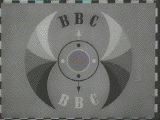 Television sets manufactured before the 1970s made extensive use of valves as opposed to more reliable “solid state” components such as transistors and integrated circuits; these valve-based sets often required adjustment of controls such as brightness and vertical hold before the start of the programme as well as allowing for a period for the TV to have warmed up properly, hence the BBC showing a caption known as a tuning signal for a while before the programme starts which enabled the teacher to make last minute adjustments to the picture settings if required. This Abram Games-designed “angel wings” tuning signal was shown before the start of each days’ broadcast in the 1950s, and continued to be used before schools programmes up until circa 1964, even after its use had been discontinued elsewhere.
Television sets manufactured before the 1970s made extensive use of valves as opposed to more reliable “solid state” components such as transistors and integrated circuits; these valve-based sets often required adjustment of controls such as brightness and vertical hold before the start of the programme as well as allowing for a period for the TV to have warmed up properly, hence the BBC showing a caption known as a tuning signal for a while before the programme starts which enabled the teacher to make last minute adjustments to the picture settings if required. This Abram Games-designed “angel wings” tuning signal was shown before the start of each days’ broadcast in the 1950s, and continued to be used before schools programmes up until circa 1964, even after its use had been discontinued elsewhere.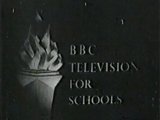 The first transmitted BBC programme for schools (Geography) was broadcast on 24 September 1957 from the Lime Grove studios, with only one schools programme shown each afternoon during term time to begin with, and all the initial programmes such as Living In The Commonwealth and Science and Life were predominantly aimed at older children. A short 5 second filmed ident sequence with orchestral accompaniment was used to introduce BBC Television For Schools (as it was called), and we can perhaps assume that this film was used as an opening sequence for schools programmes until the summer term of 1960; it had certainly been dropped by 1962 when the “Schools Opening Film” was 1 minute long in duration.
The first transmitted BBC programme for schools (Geography) was broadcast on 24 September 1957 from the Lime Grove studios, with only one schools programme shown each afternoon during term time to begin with, and all the initial programmes such as Living In The Commonwealth and Science and Life were predominantly aimed at older children. A short 5 second filmed ident sequence with orchestral accompaniment was used to introduce BBC Television For Schools (as it was called), and we can perhaps assume that this film was used as an opening sequence for schools programmes until the summer term of 1960; it had certainly been dropped by 1962 when the “Schools Opening Film” was 1 minute long in duration. During the last second of the ident sequence, the torch (and the caption) momentarily flickered brighter before the continuity announcer appeared on-screen to formally introduce the programme; something that may also relate to the flashes of light used for the “bat’s wings” logo from the same period. (Indeed, elements of the “bat’s wings” design with flashes of light could be seen being used in schools continuity until October 1961; a year after it was discontinued elsewhere.) Even by 1950s standards, this style of on-screen presentation was surprisingly old-fashioned but presumably a traditional look was adopted in order to appeal to teachers that were reluctant to embrace modern technology in the classroom. However despite an initial lack of programming, schools quickly warmed to the idea of television as a teaching medium and they were eagerly buying televisions to such an extent that they had to be restrained from excessively doing so.
During the last second of the ident sequence, the torch (and the caption) momentarily flickered brighter before the continuity announcer appeared on-screen to formally introduce the programme; something that may also relate to the flashes of light used for the “bat’s wings” logo from the same period. (Indeed, elements of the “bat’s wings” design with flashes of light could be seen being used in schools continuity until October 1961; a year after it was discontinued elsewhere.) Even by 1950s standards, this style of on-screen presentation was surprisingly old-fashioned but presumably a traditional look was adopted in order to appeal to teachers that were reluctant to embrace modern technology in the classroom. However despite an initial lack of programming, schools quickly warmed to the idea of television as a teaching medium and they were eagerly buying televisions to such an extent that they had to be restrained from excessively doing so.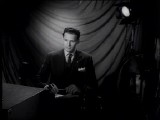 A promotional film This is the BBC gives us a brief insight into the production of schools programmes during the late 1950s; the continuity announcer pictured here is introducing Programme 3 of the series Transport and Communication. The BBC actually referred to schools broadcasts in period literature as being “Broadcasts To Schools”.
A promotional film This is the BBC gives us a brief insight into the production of schools programmes during the late 1950s; the continuity announcer pictured here is introducing Programme 3 of the series Transport and Communication. The BBC actually referred to schools broadcasts in period literature as being “Broadcasts To Schools”.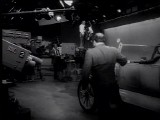 Programme 3 of the aforementioned Transport and Communication series was all about the history of the motor car, so an example of the very first mass produced car – the Model T Ford – was placed in the studio. The presenter was Arthur Garratt (pictured here next to the car).
Programme 3 of the aforementioned Transport and Communication series was all about the history of the motor car, so an example of the very first mass produced car – the Model T Ford – was placed in the studio. The presenter was Arthur Garratt (pictured here next to the car).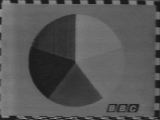 The tuning signal caption shown here is likely to have been first used as early as Autumn Term 1960 (when a morning schools programme was introduced); it was used before the start of each schools programme and consisted of a circle divided into five segments of black, white and three shades of grey in the style of a pie chart on a pale grey background, hence the term “BBC Schools Pie Chart”. From (at least) 1964 to 1967 there was a countdown sequence used before the start of the programme which had the pie chart slowly disappear; the circular chart was divided into small segments, with each segment of the pie chart being replaced by the corresponding segment of a plain clock face (identical to the clock face below minus the second hand) starting from the top, one for each second in a clockwise direction. A piece of music written by Lionel Salter entitled “We are almost ready to begin” was used to accompany the animation from 1964 onwards, and the tune’s duration was 1 minute 55 seconds, with 5 seconds’ silence for the announcement ID. (The first pie chart was also branded ‘BBC tv’ unlike the BBC branding shown here that was used from 1967 onwards.)
The tuning signal caption shown here is likely to have been first used as early as Autumn Term 1960 (when a morning schools programme was introduced); it was used before the start of each schools programme and consisted of a circle divided into five segments of black, white and three shades of grey in the style of a pie chart on a pale grey background, hence the term “BBC Schools Pie Chart”. From (at least) 1964 to 1967 there was a countdown sequence used before the start of the programme which had the pie chart slowly disappear; the circular chart was divided into small segments, with each segment of the pie chart being replaced by the corresponding segment of a plain clock face (identical to the clock face below minus the second hand) starting from the top, one for each second in a clockwise direction. A piece of music written by Lionel Salter entitled “We are almost ready to begin” was used to accompany the animation from 1964 onwards, and the tune’s duration was 1 minute 55 seconds, with 5 seconds’ silence for the announcement ID. (The first pie chart was also branded ‘BBC tv’ unlike the BBC branding shown here that was used from 1967 onwards.)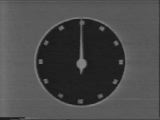 From 1967 until (at least) November 1974, the ‘vanishing segments’ animation used for the final minute was replaced by this simple clock face with a single continuously moving second hand, though the pie chart itself was still being shown prior to the final minute countdown to the programme start; the accompanying music now being used was usually a percussive piece known as “Guadalajara” that was written by Leonard Salzedo (who also wrote the Open University theme that was the first few bars of a longer piece). Broadcast quality copies (albeit recorded on film) of this pie chart and clock sequence exist before the start of some BBC Northern Ireland schools programmes because an ident was sometimes recorded alongside the programme.
From 1967 until (at least) November 1974, the ‘vanishing segments’ animation used for the final minute was replaced by this simple clock face with a single continuously moving second hand, though the pie chart itself was still being shown prior to the final minute countdown to the programme start; the accompanying music now being used was usually a percussive piece known as “Guadalajara” that was written by Leonard Salzedo (who also wrote the Open University theme that was the first few bars of a longer piece). Broadcast quality copies (albeit recorded on film) of this pie chart and clock sequence exist before the start of some BBC Northern Ireland schools programmes because an ident was sometimes recorded alongside the programme.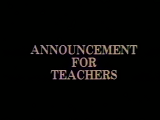 Occasionally an “Announcement For Teachers” may have been read during the final minute whilst the clock hand was steadily moving around the face to the 12 o’clock position when the programme starts, with this caption being overlaid on the clock, but more commonly such announcements were made at other times when this caption on its own would have been displayed. (The same caption was also used later in the 1970s for announcements.)
Occasionally an “Announcement For Teachers” may have been read during the final minute whilst the clock hand was steadily moving around the face to the 12 o’clock position when the programme starts, with this caption being overlaid on the clock, but more commonly such announcements were made at other times when this caption on its own would have been displayed. (The same caption was also used later in the 1970s for announcements.)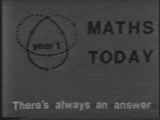 Then of course there were the programmes themselves – BBC Schools programming caters for a wide range of subjects and abilities, with series such as Maths Today and Maths Workshop (for older children); the latter being shown well into the 1970s despite being made in black and white. Programmes were often repeated for the benefit of teachers so that they could try and incorporate them into the school timetable which was often difficult since many schools had no form of video recording at that time.
Then of course there were the programmes themselves – BBC Schools programming caters for a wide range of subjects and abilities, with series such as Maths Today and Maths Workshop (for older children); the latter being shown well into the 1970s despite being made in black and white. Programmes were often repeated for the benefit of teachers so that they could try and incorporate them into the school timetable which was often difficult since many schools had no form of video recording at that time.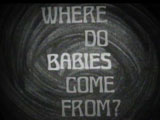 Here is an example of a BBC Schools sex education programme from the late 1960s that would inevitably provide a useful classroom resource triggering a discussion about the facts of life, with television being able to provide a far more powerful illustrative medium compared to books or blackboard drawings for this particular topic.
Here is an example of a BBC Schools sex education programme from the late 1960s that would inevitably provide a useful classroom resource triggering a discussion about the facts of life, with television being able to provide a far more powerful illustrative medium compared to books or blackboard drawings for this particular topic. Very occasionally the pie chart tuning signal itself would feature as part of an engineering test startup sequence if such a test was scheduled for a weekday morning during term time, in which case the pie chart tuning signal would appear on screen then very slowly fade away over the course of a minute to leave a black screen before appearing again shortly before the start of the first programme. The sequence would also feature a greyscale (sawtooth) tuning pattern with tone.
Very occasionally the pie chart tuning signal itself would feature as part of an engineering test startup sequence if such a test was scheduled for a weekday morning during term time, in which case the pie chart tuning signal would appear on screen then very slowly fade away over the course of a minute to leave a black screen before appearing again shortly before the start of the first programme. The sequence would also feature a greyscale (sawtooth) tuning pattern with tone.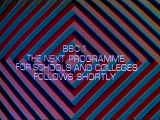 With more and more schools programmes being made in colour as well as more and more schools acquiring colour TV’s – though there were still a significant number of primary schools in particular that had only black and white televisions even at the end of the 1970s – the pie chart’s days were obviously numbered, therefore something more contemporary was devised for schools programme presentation.
With more and more schools programmes being made in colour as well as more and more schools acquiring colour TV’s – though there were still a significant number of primary schools in particular that had only black and white televisions even at the end of the 1970s – the pie chart’s days were obviously numbered, therefore something more contemporary was devised for schools programme presentation.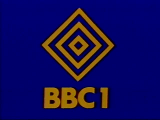
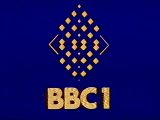
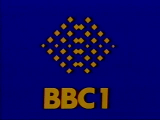
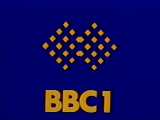
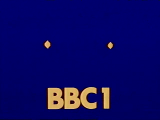
 Examples of BBC Schools programmes shown during the 1970s include A Good Read, A Job Worth Doing?, Going To Work, Maths Topics, Mathshow, Merry-go-round for primary school children, Scene, Swim, and Watch. Some of these programmes continued to be produced or shown for years after the 1970s but the introduction of GCSE qualifications (replacing ‘O’ levels, with the first GCSE exams in the Summer of 1988) made some of these old programmes redundant.
Examples of BBC Schools programmes shown during the 1970s include A Good Read, A Job Worth Doing?, Going To Work, Maths Topics, Mathshow, Merry-go-round for primary school children, Scene, Swim, and Watch. Some of these programmes continued to be produced or shown for years after the 1970s but the introduction of GCSE qualifications (replacing ‘O’ levels, with the first GCSE exams in the Summer of 1988) made some of these old programmes redundant.

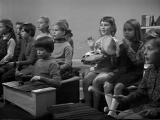
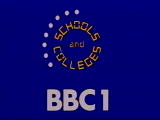 From 1977 onwards until the Summer Term of 1983 a “dots clock” was used as a replacement for the diamond animation before schools programmes, with a full circle of dots shown when the clock first appears. When watching the dots disappear one by one clockwise each second as the clock counts down to the start of the programme, you may notice that the dots don’t instantly disappear but seem to shrink as they vanish due to the mechanical nature of the clock. Various pieces of music were used to accompany the clock, including Cat Stevens’ Remember the days of the old schoolyard, a medley of ABBA songs and a rather memorable cover version of the original Star Wars theme. Originally the Schools and Colleges logo in the centre of the clock rotated every so often but it’s very likely that the turning mechanism broke down early on because the logo became static at some point not too long after the clock was first used.
From 1977 onwards until the Summer Term of 1983 a “dots clock” was used as a replacement for the diamond animation before schools programmes, with a full circle of dots shown when the clock first appears. When watching the dots disappear one by one clockwise each second as the clock counts down to the start of the programme, you may notice that the dots don’t instantly disappear but seem to shrink as they vanish due to the mechanical nature of the clock. Various pieces of music were used to accompany the clock, including Cat Stevens’ Remember the days of the old schoolyard, a medley of ABBA songs and a rather memorable cover version of the original Star Wars theme. Originally the Schools and Colleges logo in the centre of the clock rotated every so often but it’s very likely that the turning mechanism broke down early on because the logo became static at some point not too long after the clock was first used.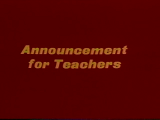 Autumn Term 1983 saw schools programmes permanently move to BBC2 and the use of a dots clock was abandoned at this point in favour of a more conventional “Daytime on 2” style of continuity, though the “Coming Shortly…” method of filling short gaps in the schedule continued for a while longer as well as a 15 second digital countdown timer being adopted later on in the decade. More and more schools now had video recorders so could easily record programmes and play them back at times to suit the lessons as opposed to timing the lessons to fit in with the television programmes.
Autumn Term 1983 saw schools programmes permanently move to BBC2 and the use of a dots clock was abandoned at this point in favour of a more conventional “Daytime on 2” style of continuity, though the “Coming Shortly…” method of filling short gaps in the schedule continued for a while longer as well as a 15 second digital countdown timer being adopted later on in the decade. More and more schools now had video recorders so could easily record programmes and play them back at times to suit the lessons as opposed to timing the lessons to fit in with the television programmes.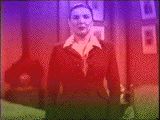 Prior to the 1960s, this is how a few people had their first view of ‘colour’ television – in the 1950s you could buy a ‘colourising’ filter, place it over your existing black and white screen, and let your imagination do the rest… John Logie Baird, the pioneer of television, was working on stereoscopic colour television shortly before his death in 1946, and the Americans were conducting experiments. But the technology was very complex; the problem was how to transmit colour information alongside an existing black and white image, therefore maintaining ‘backwards’ compatibility with existing receivers.
Prior to the 1960s, this is how a few people had their first view of ‘colour’ television – in the 1950s you could buy a ‘colourising’ filter, place it over your existing black and white screen, and let your imagination do the rest… John Logie Baird, the pioneer of television, was working on stereoscopic colour television shortly before his death in 1946, and the Americans were conducting experiments. But the technology was very complex; the problem was how to transmit colour information alongside an existing black and white image, therefore maintaining ‘backwards’ compatibility with existing receivers.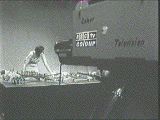 From 10 October 1955 the BBC experimented with colour television, firstly with a 405 line version of the American NTSC system – the first generally available electronic-based system of colour transmission designed for backwards compatability with existing monochrome transmissions. Low power test transmissions were from Alexandra Palace (one of the original studios being re-equipped for the purpose), using specially made receivers, but to start a public 405-line colour service at this stage would result in Britain having to commit long term to the pre-war 405-line standard which was out of step with continental Europe (which used the superior post-war 625 line system).
From 10 October 1955 the BBC experimented with colour television, firstly with a 405 line version of the American NTSC system – the first generally available electronic-based system of colour transmission designed for backwards compatability with existing monochrome transmissions. Low power test transmissions were from Alexandra Palace (one of the original studios being re-equipped for the purpose), using specially made receivers, but to start a public 405-line colour service at this stage would result in Britain having to commit long term to the pre-war 405-line standard which was out of step with continental Europe (which used the superior post-war 625 line system).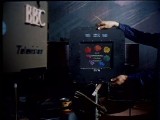
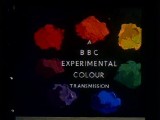
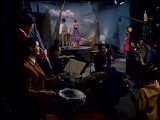 The song used in this particular test broadcast was “Early one morning”, and the participants had to wear different makeup compared with that used for monochrome broadcasts as well as brightly-coloured costumes featuring different colours.
The song used in this particular test broadcast was “Early one morning”, and the participants had to wear different makeup compared with that used for monochrome broadcasts as well as brightly-coloured costumes featuring different colours.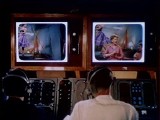 A major problem with early colour television equipment was its unreliability combined with the huge number of adjustments that were required for a good quality picture. The colour television receivers used for the BBC tests were individually handbuilt by companies such as Bush and Philips, with various specialist components such as colour television tubes having to be sourced from America; the sets themselves were designed to be easily maintainable by engineers despite their huge complexity, which was particularly true of the receivers constructed for the later PAL tests.
A major problem with early colour television equipment was its unreliability combined with the huge number of adjustments that were required for a good quality picture. The colour television receivers used for the BBC tests were individually handbuilt by companies such as Bush and Philips, with various specialist components such as colour television tubes having to be sourced from America; the sets themselves were designed to be easily maintainable by engineers despite their huge complexity, which was particularly true of the receivers constructed for the later PAL tests.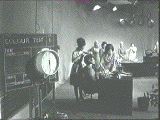 Later the French developed SECAM (Sequential Colour with Memory), and Telefunken in Germany developed PAL (Phase Alternate Line) which represented two differing approaches of solving the colour problems encountered with NTSC, and the BBC experimented using both, though there were other problems to be solved. The insensitivity and inaccuracy of early colour tv cameras and its associated circuitry meant that without adjustments the resulting picture either had a colour cast and/or made flesh tones look too red, so extra studio lighting and make-up was required. In 1961 a committee meeting in Stockholm allocated UHF frequencies for 36 European countries, enabling the Government to plan ahead.
Later the French developed SECAM (Sequential Colour with Memory), and Telefunken in Germany developed PAL (Phase Alternate Line) which represented two differing approaches of solving the colour problems encountered with NTSC, and the BBC experimented using both, though there were other problems to be solved. The insensitivity and inaccuracy of early colour tv cameras and its associated circuitry meant that without adjustments the resulting picture either had a colour cast and/or made flesh tones look too red, so extra studio lighting and make-up was required. In 1961 a committee meeting in Stockholm allocated UHF frequencies for 36 European countries, enabling the Government to plan ahead.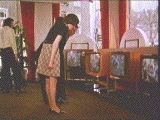 After much deliberation, the government chose the PAL system – which although was more complex (hence expensive) it gave the best results. Most of Europe also chose PAL, and BBC2 started its UHF 625-line colour service on 1 July 1967 with Wimbledon tennis coverage (there were a few earlier test transmissions), though initially only a few programmes in the schedule were actually in colour. BBC2’s first colour ident was simply the standard ‘2’ logo electronically-tinted pale blue.
After much deliberation, the government chose the PAL system – which although was more complex (hence expensive) it gave the best results. Most of Europe also chose PAL, and BBC2 started its UHF 625-line colour service on 1 July 1967 with Wimbledon tennis coverage (there were a few earlier test transmissions), though initially only a few programmes in the schedule were actually in colour. BBC2’s first colour ident was simply the standard ‘2’ logo electronically-tinted pale blue.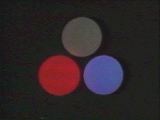
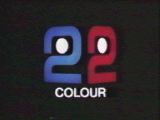
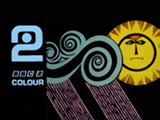 By December 1967 colour was available in London, the Midlands, the North and South of England. Other early colour programmes included The World About Us (which basically used stock colour documentary footage – the first programme featured volcanoes), Almost Human (about domesticated animals) and International Cabaret. The BBC-produced 1968 Eurovision Song Contest was shown live in black-and-white on BBC1 and in colour in West Germany but repeated the next day in colour on BBC2.
By December 1967 colour was available in London, the Midlands, the North and South of England. Other early colour programmes included The World About Us (which basically used stock colour documentary footage – the first programme featured volcanoes), Almost Human (about domesticated animals) and International Cabaret. The BBC-produced 1968 Eurovision Song Contest was shown live in black-and-white on BBC1 and in colour in West Germany but repeated the next day in colour on BBC2.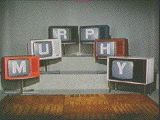 There were many more manufacturers of television receivers in the 1960s than there are today; Sobell, MacMichael, GEC, Ekco, HMV, ITT, and Ferguson were just a few of the more notable ones, though later on more obscure models were imported to meet increasing demand. Early colour television sets used valves and were very bulky, expensive, unreliable, some had poor colour quality, and some sets were prone to overheating. After a succession of house fires people were advised to stay in the same room as their television for one hour after it was switched off.
There were many more manufacturers of television receivers in the 1960s than there are today; Sobell, MacMichael, GEC, Ekco, HMV, ITT, and Ferguson were just a few of the more notable ones, though later on more obscure models were imported to meet increasing demand. Early colour television sets used valves and were very bulky, expensive, unreliable, some had poor colour quality, and some sets were prone to overheating. After a succession of house fires people were advised to stay in the same room as their television for one hour after it was switched off.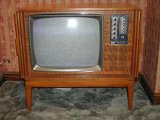 The HMV Colourmaster was a colour television featuring a genuine world-first: an all-transistor chassis with no valves apart from the cathode ray tube which technically speaking is a valve in itself; a design practice that was soon to be universally adopted. Despite a lack of valves, the Colourmaster was still a very bulky television due to the complexity of the transistor circuitry and the sheer bulk of the colour display tube. Available in 19″ and 25″ sizes, the price of the 25″ Colourmaster was an eye-watering £362.18s (pre-decimal) in 1968, so it’s no wonder that colour televisions were usually rented as opposed to purchased outright. (By comparison you could buy a very decent black and white television for a quarter of the price.)
The HMV Colourmaster was a colour television featuring a genuine world-first: an all-transistor chassis with no valves apart from the cathode ray tube which technically speaking is a valve in itself; a design practice that was soon to be universally adopted. Despite a lack of valves, the Colourmaster was still a very bulky television due to the complexity of the transistor circuitry and the sheer bulk of the colour display tube. Available in 19″ and 25″ sizes, the price of the 25″ Colourmaster was an eye-watering £362.18s (pre-decimal) in 1968, so it’s no wonder that colour televisions were usually rented as opposed to purchased outright. (By comparison you could buy a very decent black and white television for a quarter of the price.)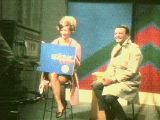 By 1968 many ITV franchises realised that they too had to prepare themselves for a future colour service. The first to do so was TWW, followed closely by ABC: ironically both were to lose their franchise the same year (though ABC joined up with Rediffusion to form Thames). TWW’s first (and hence ITV’s first) colour camera production (pictured) was Colour One – it was directed by Mike Towers (later Managing Director of HTV) and was done purely for internal demonstration purposes. No recording exists because there was nothing available to record it with.
By 1968 many ITV franchises realised that they too had to prepare themselves for a future colour service. The first to do so was TWW, followed closely by ABC: ironically both were to lose their franchise the same year (though ABC joined up with Rediffusion to form Thames). TWW’s first (and hence ITV’s first) colour camera production (pictured) was Colour One – it was directed by Mike Towers (later Managing Director of HTV) and was done purely for internal demonstration purposes. No recording exists because there was nothing available to record it with.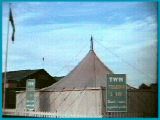 TWW also took out their colour cameras (EMI type 204 Vidicon using mirror optical splitting and a turret of wide angle adaptors, originally made for medical applications) for publicity demonstrations – pictured is the TWW tent at a Welsh Eisteddfod. The colour equipment used was a work of ingenuity – only a single RGB monitor was available and the only colour encoder available was a NTSC encoder, so it had to be modified to provide a PAL output which was no easy task.
TWW also took out their colour cameras (EMI type 204 Vidicon using mirror optical splitting and a turret of wide angle adaptors, originally made for medical applications) for publicity demonstrations – pictured is the TWW tent at a Welsh Eisteddfod. The colour equipment used was a work of ingenuity – only a single RGB monitor was available and the only colour encoder available was a NTSC encoder, so it had to be modified to provide a PAL output which was no easy task.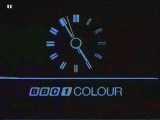
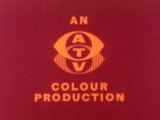
 During the early 1970s much of England, Wales, Northern Ireland, and Scotland were still totally without colour television, and despite a mini-budget in July 1971 boosting sales, by 1972 only 17% of households had colour television receivers though the Olympic Games in that year did help to stimulate interest. However tales of overheating and unreliability still put off many potential purchasers and the cost was still prohibitive for some, though TV rental provided an affordable alternative to outright purchase.
During the early 1970s much of England, Wales, Northern Ireland, and Scotland were still totally without colour television, and despite a mini-budget in July 1971 boosting sales, by 1972 only 17% of households had colour television receivers though the Olympic Games in that year did help to stimulate interest. However tales of overheating and unreliability still put off many potential purchasers and the cost was still prohibitive for some, though TV rental provided an affordable alternative to outright purchase.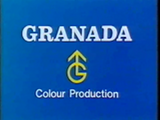 By 1976 colour television sets were smaller, far more reliable and they no longer caught fire due to their ‘solid-state’ design, meaning that no valves are used apart from the picture tube. Portable colour televisions became available, though most of these were still tied to the mains supply due to their high power consumption; the exceptions usually had 10 inch or smaller screens. Picture quality became vastly improved, and the falling price of sets meant that the number of colour televisions had rapidly increased to over 7.5 million by 1976. The Home Entertainment Show 1976 in London showcased recent innovations such as teletext, and colour transmissions finally reached the Channel Islands in the same year (it took a long time due to the technical difficulties in providing a UHF link to England).
By 1976 colour television sets were smaller, far more reliable and they no longer caught fire due to their ‘solid-state’ design, meaning that no valves are used apart from the picture tube. Portable colour televisions became available, though most of these were still tied to the mains supply due to their high power consumption; the exceptions usually had 10 inch or smaller screens. Picture quality became vastly improved, and the falling price of sets meant that the number of colour televisions had rapidly increased to over 7.5 million by 1976. The Home Entertainment Show 1976 in London showcased recent innovations such as teletext, and colour transmissions finally reached the Channel Islands in the same year (it took a long time due to the technical difficulties in providing a UHF link to England). By the end of the 1970s manufacturers were looking to add more features to their televisions, and the advent of reasonably priced silicon chip circuitry meant that special features such as teletext could be added (a free information service whereby information is transmitted as ‘pages’) as well as sometimes other short-lived features such as ‘viewdata’ (a primitive internet-style service using crude block graphics as well as text) and bat-and-ball style video games. Teletext was the only special feature that became popular because it was cheap to add and free to use, together with remote control operation and electronic tuning. Early wireless remote controls mainly used ultrasound waves which were inaudible to humans but could make dogs bark.
By the end of the 1970s manufacturers were looking to add more features to their televisions, and the advent of reasonably priced silicon chip circuitry meant that special features such as teletext could be added (a free information service whereby information is transmitted as ‘pages’) as well as sometimes other short-lived features such as ‘viewdata’ (a primitive internet-style service using crude block graphics as well as text) and bat-and-ball style video games. Teletext was the only special feature that became popular because it was cheap to add and free to use, together with remote control operation and electronic tuning. Early wireless remote controls mainly used ultrasound waves which were inaudible to humans but could make dogs bark.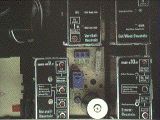 The 1980s and 1990s saw further developments in television design and technology. As early as the mid 1970s the German set maker Grundig had introduced a system using easily changeable internal modules with diagnostic lights so the set could even tell the engineer which part needed replacing. This idea never caught on but the basic concept of making the set simpler and cheaper to make remained. In 1983 Ferguson introduced the TX100 chassis, with some impressive claims (23% fewer adjustments, 5% fewer components, etc.), and new technologies continued to add features and reduce costs. NICAM stereo sound was introduced at the end of the 1980s, and television has continued to evolve since then with digital widescreen broadcasting commencing in 1998, high definition (HD) broadcasts beginning in the UK in 2006, and ultra high definition (UHD, or 4K) broadcasting is now a reality; experiments using this technology having taken place from 2012 onwards. Even higher resolutions are currently being considered though another brief flirtation with 3D television seems to have ended, at least for the time being.
The 1980s and 1990s saw further developments in television design and technology. As early as the mid 1970s the German set maker Grundig had introduced a system using easily changeable internal modules with diagnostic lights so the set could even tell the engineer which part needed replacing. This idea never caught on but the basic concept of making the set simpler and cheaper to make remained. In 1983 Ferguson introduced the TX100 chassis, with some impressive claims (23% fewer adjustments, 5% fewer components, etc.), and new technologies continued to add features and reduce costs. NICAM stereo sound was introduced at the end of the 1980s, and television has continued to evolve since then with digital widescreen broadcasting commencing in 1998, high definition (HD) broadcasts beginning in the UK in 2006, and ultra high definition (UHD, or 4K) broadcasting is now a reality; experiments using this technology having taken place from 2012 onwards. Even higher resolutions are currently being considered though another brief flirtation with 3D television seems to have ended, at least for the time being.
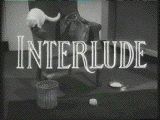 Programmes that featured flowers and plants were produced almost from day one; the very first week of programmes back in 1936 included one featuring prize chrysanthemums. Alexandra Palace (the BBC’s base from 1936 to 1960) has gardens which were an obvious choice to be used if the limited studio facilities were otherwise unavailable, though live outdoor programming was restricted sometimes by the unpredictable English weather.
Programmes that featured flowers and plants were produced almost from day one; the very first week of programmes back in 1936 included one featuring prize chrysanthemums. Alexandra Palace (the BBC’s base from 1936 to 1960) has gardens which were an obvious choice to be used if the limited studio facilities were otherwise unavailable, though live outdoor programming was restricted sometimes by the unpredictable English weather.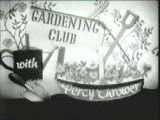 In 1956 the BBC started a monthly series that catered for real gardening enthusiasts, called Gardening Club. It was a big success, to such an extent that it established presenter Percy Thrower as a major celebrity (in a similar vein to Barry Bucknell, who was to be similiarly associated with do-it-yourself programmes).
In 1956 the BBC started a monthly series that catered for real gardening enthusiasts, called Gardening Club. It was a big success, to such an extent that it established presenter Percy Thrower as a major celebrity (in a similar vein to Barry Bucknell, who was to be similiarly associated with do-it-yourself programmes).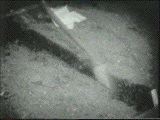 Outdoor television presents a whole set of challenges (rain, wind, etc.), but mishaps can still happen in the ‘controlled’ indoor studio environment. In order to effectively hear Percy Thrower’s voice, microphones were concealed in the soil (tiny radio microphones were yet to be developed), but once after he had finished putting plants into the soil, he started to water them, and since the concealed microphones were not waterproof…
Outdoor television presents a whole set of challenges (rain, wind, etc.), but mishaps can still happen in the ‘controlled’ indoor studio environment. In order to effectively hear Percy Thrower’s voice, microphones were concealed in the soil (tiny radio microphones were yet to be developed), but once after he had finished putting plants into the soil, he started to water them, and since the concealed microphones were not waterproof… In 1968 BBC2 were still experimenting with outdoor colour programming; the wide range of colours found in gardens were a natural choice for assessing colour accuracy. Six experimental gardening programmes were made using colour equipment; unfortunately all recordings of these have been lost.
In 1968 BBC2 were still experimenting with outdoor colour programming; the wide range of colours found in gardens were a natural choice for assessing colour accuracy. Six experimental gardening programmes were made using colour equipment; unfortunately all recordings of these have been lost.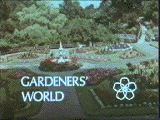 BBC2 (and colour television) was the natural home for gardening programmes, so Gardeners’ World started on Friday 5 January 1968 as a series to fulfill the demand for such programming. The main presenter was (again) Percy Thrower, though this time there were various co-presenters such as Arthur Billett, Kenneth Burras, Alice Coats and Geoffrey Smith. Gardeners’ World – with or without the apostrophe – has continued to the present day, albeit with an occasionally-changing roster of presenters.
BBC2 (and colour television) was the natural home for gardening programmes, so Gardeners’ World started on Friday 5 January 1968 as a series to fulfill the demand for such programming. The main presenter was (again) Percy Thrower, though this time there were various co-presenters such as Arthur Billett, Kenneth Burras, Alice Coats and Geoffrey Smith. Gardeners’ World – with or without the apostrophe – has continued to the present day, albeit with an occasionally-changing roster of presenters. All was running smoothly until 1976, when Percy Thrower did (in many people’s eyes) the unthinkable and appeared in a TV commercial for Garden Plus fertiliser. His name was already associated with gardening products, but this commercial meant that it was possible for viewers to watch ITV and see him actively endorsing a product, then switch over to BBC2 and see him again in the garden. The result could have confused some people, as well as going against the principles of non-commercial television, so the BBC did what they thought was necessary by sacking him.
All was running smoothly until 1976, when Percy Thrower did (in many people’s eyes) the unthinkable and appeared in a TV commercial for Garden Plus fertiliser. His name was already associated with gardening products, but this commercial meant that it was possible for viewers to watch ITV and see him actively endorsing a product, then switch over to BBC2 and see him again in the garden. The result could have confused some people, as well as going against the principles of non-commercial television, so the BBC did what they thought was necessary by sacking him.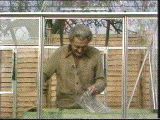 Life must go on (after all there’s the grass to be cut…), so Percy Thrower was replaced by Peter Seabrook, who didn’t exactly look like a typical gardener (quote: “He looked more like an accountant”), though the co-presenters such as Arthur Billit, Geoffrey Smith and Clay Jones (pictured) remained the same, helping to smooth the transition. Replacing Percy Thrower was always going to be difficult, but the loyalty of the viewers and the quality of the current and later presenters kept the show going. After all, the show was all about gardening and not personalities.
Life must go on (after all there’s the grass to be cut…), so Percy Thrower was replaced by Peter Seabrook, who didn’t exactly look like a typical gardener (quote: “He looked more like an accountant”), though the co-presenters such as Arthur Billit, Geoffrey Smith and Clay Jones (pictured) remained the same, helping to smooth the transition. Replacing Percy Thrower was always going to be difficult, but the loyalty of the viewers and the quality of the current and later presenters kept the show going. After all, the show was all about gardening and not personalities.
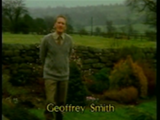
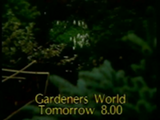 Geoffrey Smith featured in this promotion for a new series of Gardeners World (sometimes spelt without an apostrophe, as is the case here) in 1981, talking about tomato plants and how they are flowering earlier in the South of England compared to elsewhere in the UK.
Geoffrey Smith featured in this promotion for a new series of Gardeners World (sometimes spelt without an apostrophe, as is the case here) in 1981, talking about tomato plants and how they are flowering earlier in the South of England compared to elsewhere in the UK. This is what the Gardeners’ World titles looked like in 1982 – at this point the theme music was still the same as it was in the 1970s – with the typeface employed bearing a resemblance to that used by a certain brand of flower seed.
This is what the Gardeners’ World titles looked like in 1982 – at this point the theme music was still the same as it was in the 1970s – with the typeface employed bearing a resemblance to that used by a certain brand of flower seed. Garden technology may evolve with the introduction of more advanced pesticides, plant varieties and garden machinery, but Gardeners’ World still carried on regardless, celebrating its 25th anniversary in 1994. The show had been contracted out to independent producers in 1993 and some had complained about the changes, but the show must go on (as they say). In recent years the gardens featured have been in a wider range of locations due to smaller and lighter video equipment becoming available.
Garden technology may evolve with the introduction of more advanced pesticides, plant varieties and garden machinery, but Gardeners’ World still carried on regardless, celebrating its 25th anniversary in 1994. The show had been contracted out to independent producers in 1993 and some had complained about the changes, but the show must go on (as they say). In recent years the gardens featured have been in a wider range of locations due to smaller and lighter video equipment becoming available. One of the best-loved presenters of Gardeners’ World was Geoff Hamilton (1990-1996), who tragically died from a heart attack shortly before the series Geoff Hamilton’s Paradise Gardens was completed (his brother helped to complete the final episode). His garden (known as Barnsdale) was an inspiration to tired gardeners everywhere; infact there had been two ‘Barnsdales’ (the first one had become too small); the larger final one actually comprising of no less than thirty separate smaller gardens.
One of the best-loved presenters of Gardeners’ World was Geoff Hamilton (1990-1996), who tragically died from a heart attack shortly before the series Geoff Hamilton’s Paradise Gardens was completed (his brother helped to complete the final episode). His garden (known as Barnsdale) was an inspiration to tired gardeners everywhere; infact there had been two ‘Barnsdales’ (the first one had become too small); the larger final one actually comprising of no less than thirty separate smaller gardens. As well as being a well-loved presenter, Geoff Hamilton made one very significant contribution to the world of agriculture (not just gardening), notably the promotion of organic methods of pest control and the elimination of chemicals from the food chain at a time when such methods had fallen out of favour (and organic food was virtually unobtainable). Also he wasn’t afraid to show viewers the results of such organic experiments even if they had failed, since the point of the exercise was to learn from these mistakes, and crucially these organic methods were presented as an alternative to the use of conventional pesticides (which were also used as a comparison) as opposed to only being told one way of doing things.
As well as being a well-loved presenter, Geoff Hamilton made one very significant contribution to the world of agriculture (not just gardening), notably the promotion of organic methods of pest control and the elimination of chemicals from the food chain at a time when such methods had fallen out of favour (and organic food was virtually unobtainable). Also he wasn’t afraid to show viewers the results of such organic experiments even if they had failed, since the point of the exercise was to learn from these mistakes, and crucially these organic methods were presented as an alternative to the use of conventional pesticides (which were also used as a comparison) as opposed to only being told one way of doing things. From 1996, Gardeners’ World continued with Alan Titchmarsh becoming the main presenter along with Pippa Greenwood and Gay Search being regular presenters in 1998 as the show reached its 30th year. Alan Titchmarsh subsequently moved on in 2002 to other areas such as replacing Sheridan Morley as the presenter of the Radio 2 Arts Programme, and Monty Don took over as the main presenter.
From 1996, Gardeners’ World continued with Alan Titchmarsh becoming the main presenter along with Pippa Greenwood and Gay Search being regular presenters in 1998 as the show reached its 30th year. Alan Titchmarsh subsequently moved on in 2002 to other areas such as replacing Sheridan Morley as the presenter of the Radio 2 Arts Programme, and Monty Don took over as the main presenter. Gardeners’ World celebrated its 40th year in 2008 and still survives to this day despite competing series such as Ground Force vying for attention. Monty Don had to take a break in 2009 due to health concerns despite his popularity. He was replaced by co-presenter Toby Buckland in 2009, and after a short-lived revamp of the show that used 60 minute-long episodes with added features which had been likened (amongst other things) to elements of programmes such as popular motoring show Top Gear (by featuring a ‘cool wall’) and CBeebies by virtue of featuring young children, Gardeners’ World essentially returned to its roots in 2010 with a reversion to a 30-minute format, with Monty Don returning to the show soon afterwards.
Gardeners’ World celebrated its 40th year in 2008 and still survives to this day despite competing series such as Ground Force vying for attention. Monty Don had to take a break in 2009 due to health concerns despite his popularity. He was replaced by co-presenter Toby Buckland in 2009, and after a short-lived revamp of the show that used 60 minute-long episodes with added features which had been likened (amongst other things) to elements of programmes such as popular motoring show Top Gear (by featuring a ‘cool wall’) and CBeebies by virtue of featuring young children, Gardeners’ World essentially returned to its roots in 2010 with a reversion to a 30-minute format, with Monty Don returning to the show soon afterwards.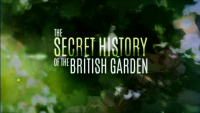 As well as Gardeners’ World there have been other gardening-related programmes including The Secret History of the British Garden, also presented by Monty Don. This four-part series covering the 17th, 18th, 19th and 20th centuries was originally broadcast in December 2017 and charted the progress of gardening from when it was a preserve of wealthy land owners and royalty right up to the present day as a mass market hobby. January 2018 is the 50th anniversary of Gardeners’ World and the UK’s love affair with horticulture shows no signs of going away.
As well as Gardeners’ World there have been other gardening-related programmes including The Secret History of the British Garden, also presented by Monty Don. This four-part series covering the 17th, 18th, 19th and 20th centuries was originally broadcast in December 2017 and charted the progress of gardening from when it was a preserve of wealthy land owners and royalty right up to the present day as a mass market hobby. January 2018 is the 50th anniversary of Gardeners’ World and the UK’s love affair with horticulture shows no signs of going away.